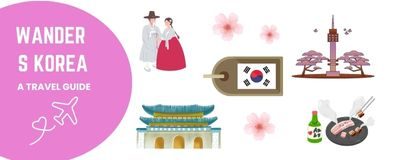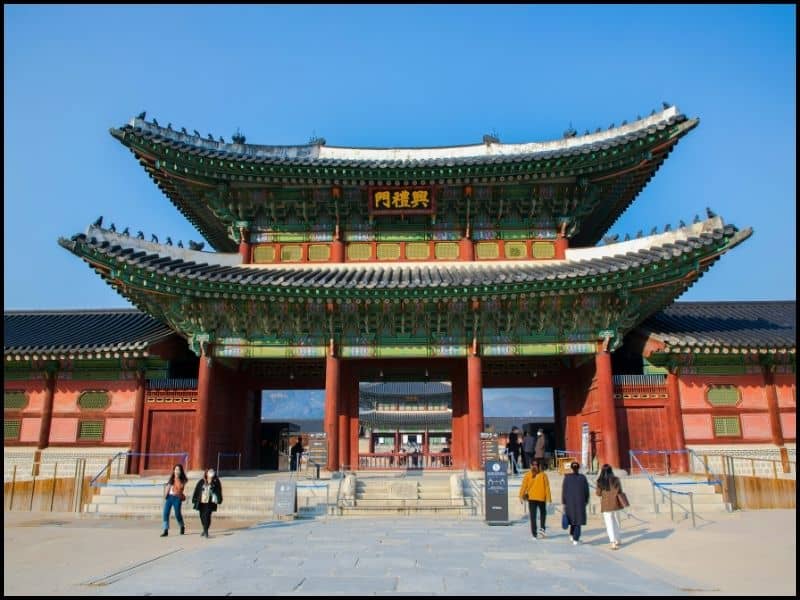
With so many free things to do in Seoul, it wasn’t easy to narrow down the list. I’ve shared some activities I’ve experienced and enjoyed and popular options I still need to visit.
This guide isn’t exhaustive; the city is filled with neighborhoods and parks where you can wander, relax, and take in the sights.
Seoul is huge, and while some attractions are conveniently located close to each other, others require more planning and travel.
I always recommend using Naver to map out your itinerary, as it helps you get a clear sense of travel times and the surrounding areas. Enjoy your adventures in this dynamic city!
25 Free Things To Do In Seoul
1. Explore Bukchon Hanok Village
High on the list of free things to do in Seoul is Bukchon Hanok Village.
Nestled between Gyeongbokgung and Changdeokgung Palaces, this historic neighborhood is filled with beautifully preserved hanoks, traditional Korean houses that let you step back in time.
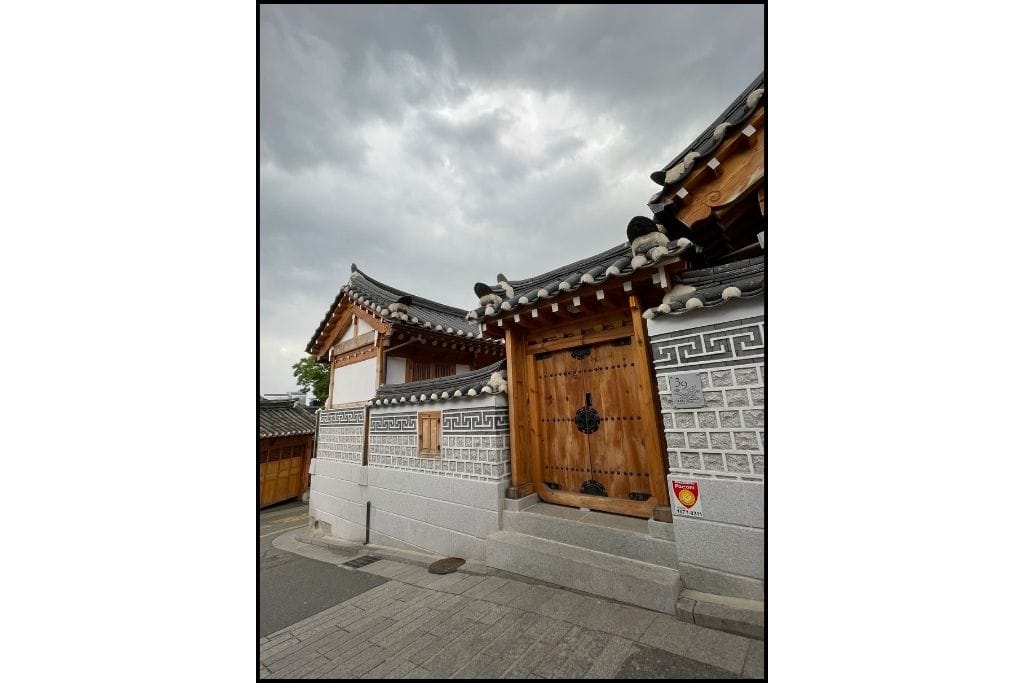
As you meander through the tiny lanes, you will become enthralled with the gorgeous wooden beams and tiled roofs that characterize this traditional neighborhood.
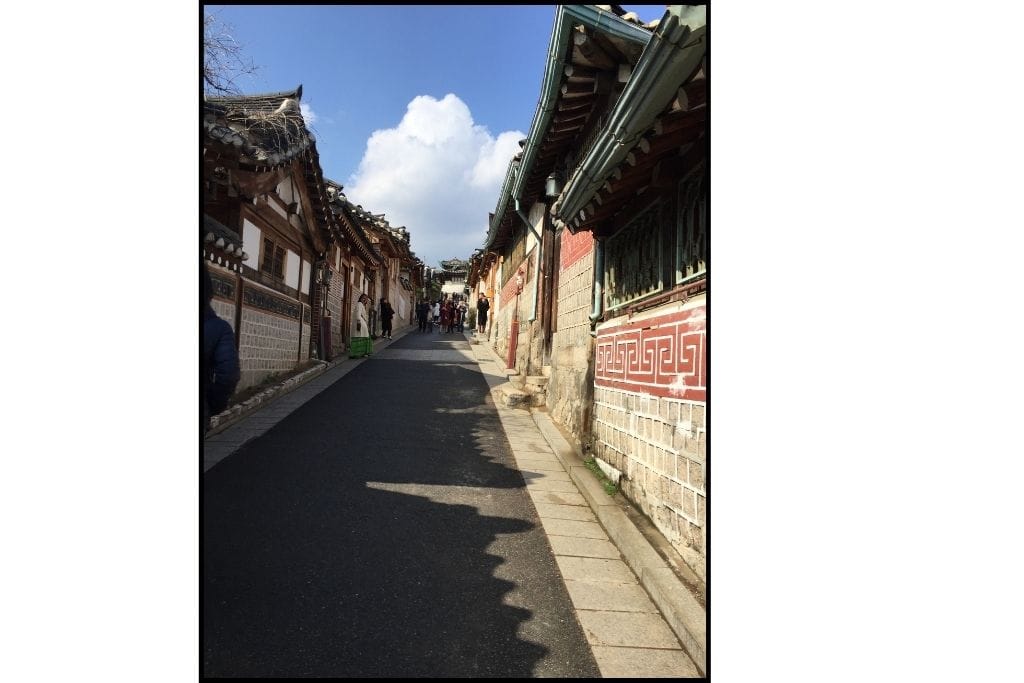
It is important to keep in mind that while this is a popular tourist spot, there are actual residents living there.
Please be mindful and respect the area by speaking quietly to minimize noise. Please do not yell.

Signs are posted to remind tourists of this. Additionally, do not litter and be respectful of the privacy of the homes.
Check the website for more information
Directions: Subway from Anguk station on line 3, take exit 2, and walk straight about 300m. Or from exit 3, take a quick first left and walk about 200m
2. Walk Along Insadong Street (인사동)
Insadong is a cultural district offering plenty of free things to do, from exploring art galleries to window shopping at souvenir shops and craft stores.
Visitors can also wander through Ssamzigil, a unique open-air, four-story mall filled with handmade goods.
I love exploring this outdoor mall for special gifts. There are so many cute handmade goods here.
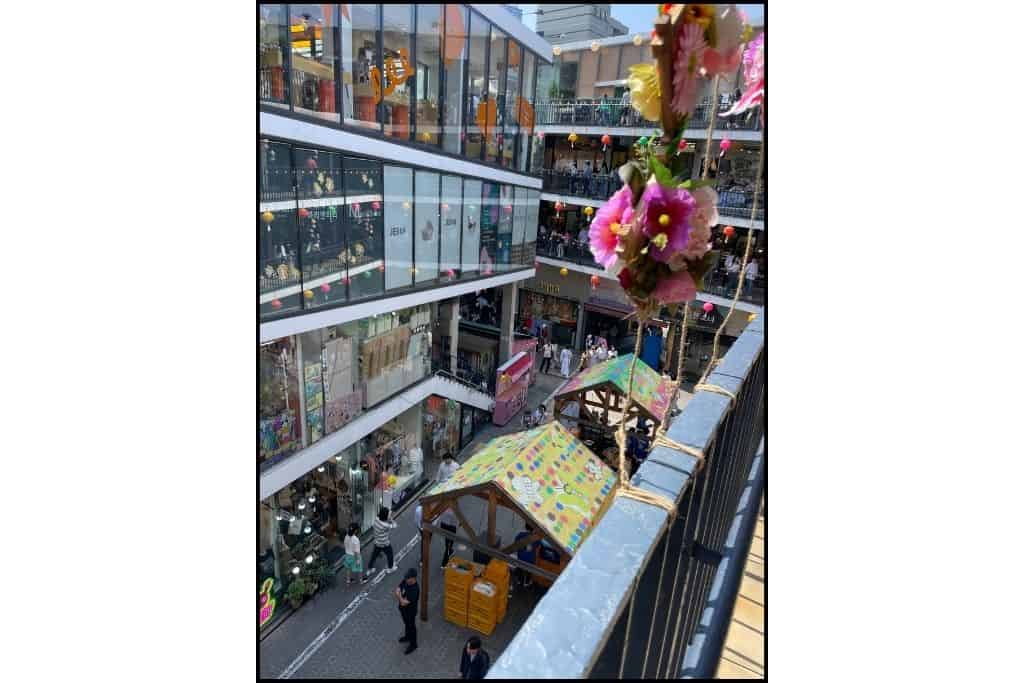
Insadong’s main street is packed with shops, and on weekends, it becomes a pedestrian zone, with vendors setting up carts along the way.
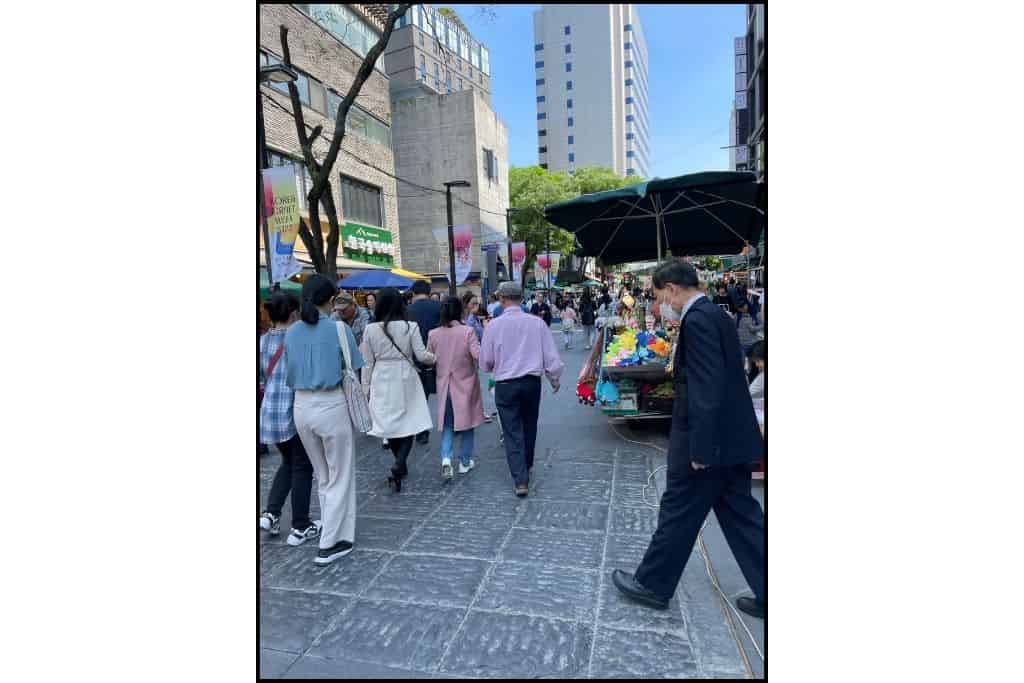
Don’t miss the chance to wander down the smaller streets and alleyways, where even more art galleries and hidden shops await.
Insadong has a lot of wonderful art galleries. Some are on the main street while others are tucked away on side streets.
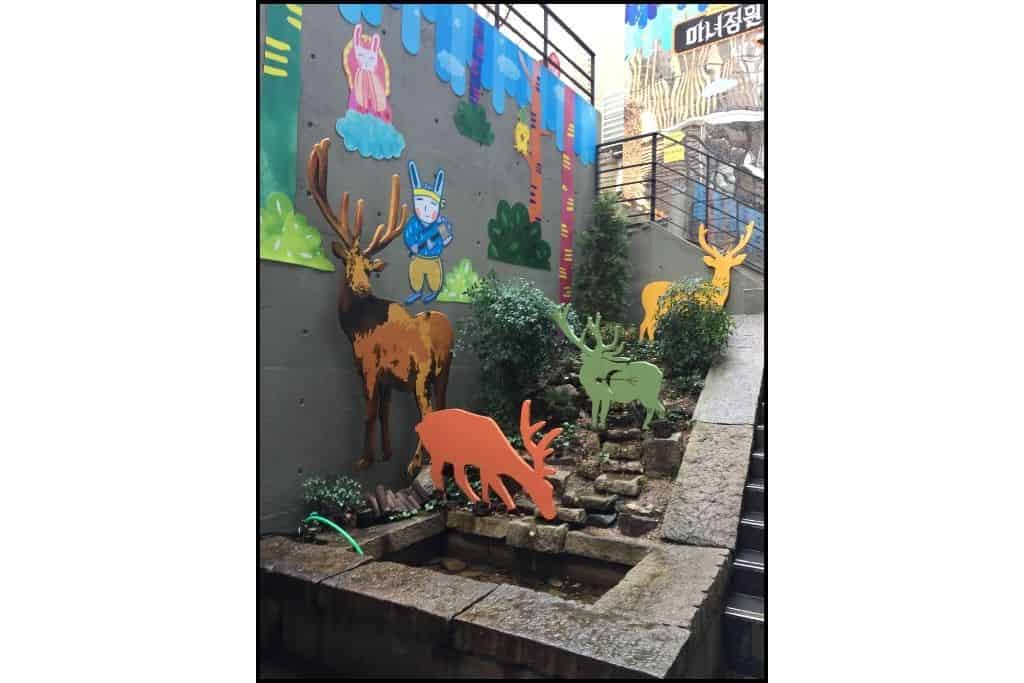
Don’t be afraid to wander off the main street.
Check the Ssamzigil website for more information
Directions: From Anguk subway station (line 3, exit 6). Go straight 100m and turn left to Insadong-gil.
3. Visit Jogyesa Temple
Visiting Jogyesa Temple is one of my favorite free things to do in Seoul, especially when I’m in Insadong.
Located in the center of Seoul’s Insadong neighborhood, it offers a peaceful escape from the city’s hustle and bustle. People frequently visit Insadong Street and the Jogyesa Temple together.
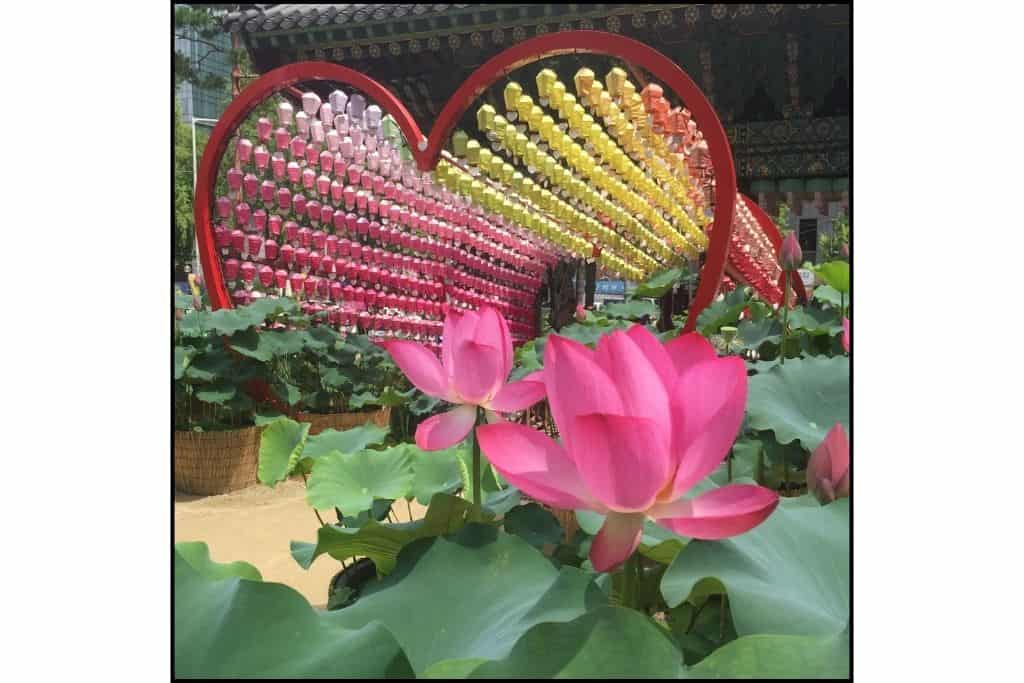
As the main temple of the Jogye Order, it holds a significant place in Korean Buddhism.
Its stunning main hall, framed by towering, centuries-old trees adorned with colorful lanterns, creates a serene and calming atmosphere.
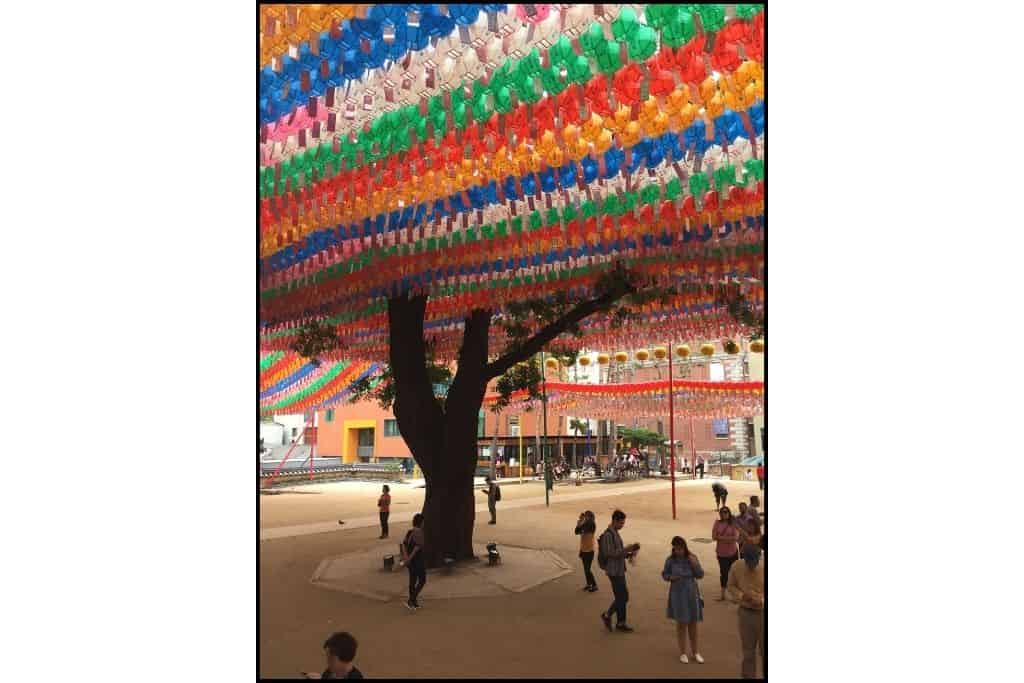
One of the best free activities at Jogyesa is strolling through its tranquil grounds, soaking in the peaceful environment.
The spacious courtyard features the impressive Daeungjeon Hall, home to three golden Buddha statues, and offers a chance to observe locals engaging in traditional Buddhist rituals.
During the Lotus Lantern Festival in spring, the temple is especially magical, glowing with hundreds of colorful lanterns.
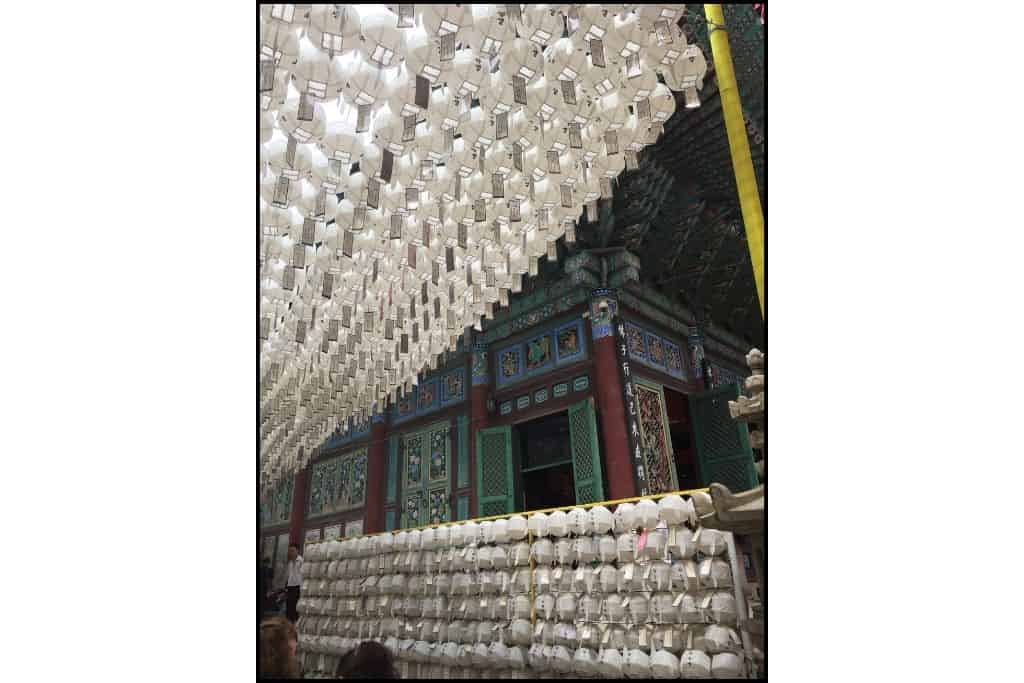
Jogyesa Temple is a must-visit for anyone seeking a cultural experience on a budget. It perfectly blends history, spirituality, and tranquility, making it an essential stop for visitors to Seoul.
Directions: subway station Anguk exit 6, walk straight to the Anguk-dong/intersection, and bear left. Walk to the crosswalk at the next stop light. The gate to Jogyesa is across the street.
Open 24 hours, free
Check the website for more information
4. Stroll Along the Cheonggyecheon Stream
Cheonggyecheon Stream is a serene 11-kilometer urban oasis in the heart of Seoul.
It is a peaceful retreat from the city’s fast pace. Originally an ancient waterway, it was restored to create a scenic spot perfect for strolls and relaxation.
Visiting Cheonggyecheon is one of the best free things to do in Seoul. With its lush greenery and art installations, the stream offers a unique blend of natural beauty and modern design.
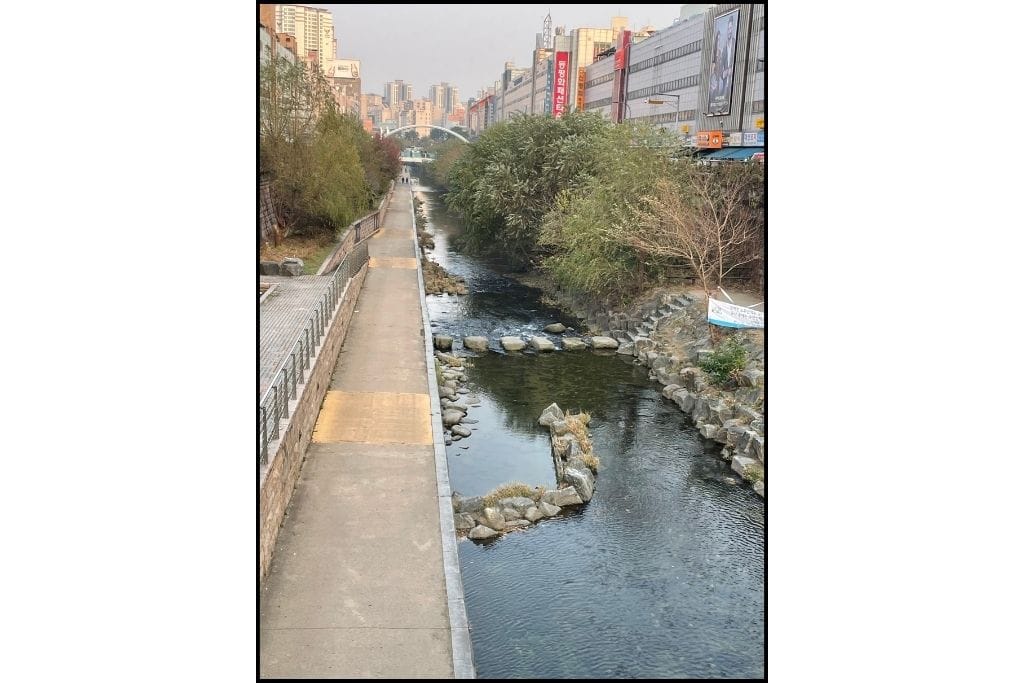
Cheonggyecheon Stream transforms into a beautiful landscape at night with soft lights bouncing off the water, providing a calm and enchanting atmosphere perfect for an evening stroll.
People can be seen hanging out with pals both throughout the day and at night.
It begins near City Hall and empties into the Han River by Hanyang University. Numerous entry points along its path offer easy access from various parts of the city.
Although the stream starts near significant landmarks like City Hall, Gwanghwamun, and Gyeongbokgung, these sites aren’t directly along the stream.
However, as you follow its course, you will pass by nearby attractions such as Gwangjang Market, Dongdaemun Design Plaza (DDP), and neighborhoods like Dongdaemun and Euljiro. Running parallel to many famous spots, the stream provides a scenic route with nearby landmarks.
Not only is the area a picturesque escape, but it also holds cultural significance, hosting events and festivals throughout the year.
Both locals and visitors take pleasure in strolling beside the stream, putting their feet in the water, or just finding a peaceful spot to sit.
Cheonggyecheon, which is always open, is still the best place to go sightseeing in Seoul on a budget.
Directions: The quickest route is to take the subway line 5 to Gwanghwamun Station exit 5, walk for 2 minutes to Cheonggye Plaza, and continue on to the stream.
Or City Hall Station on line 1 or 2, exit 4 walk for 6 minutes. There are numerous entrances along the stream as well.
5. Hanji House (Hanjigaheon) or Traditional Korean Paper Heon, formerly Hanji Culture and Industry Center.
For another free activity, go to The Traditional Korean Paper Heon (previously The Hanji Culture and Industry Center) in Insadong.
It assists visitors to learn about the lengthy history of hanji, a traditional Korean paper made from the bark of mulberry trees.
The Traditional Korean Paper Heon offers visitors an enjoyable cultural experience if they are curious about the origins and contemporary applications of hanji.
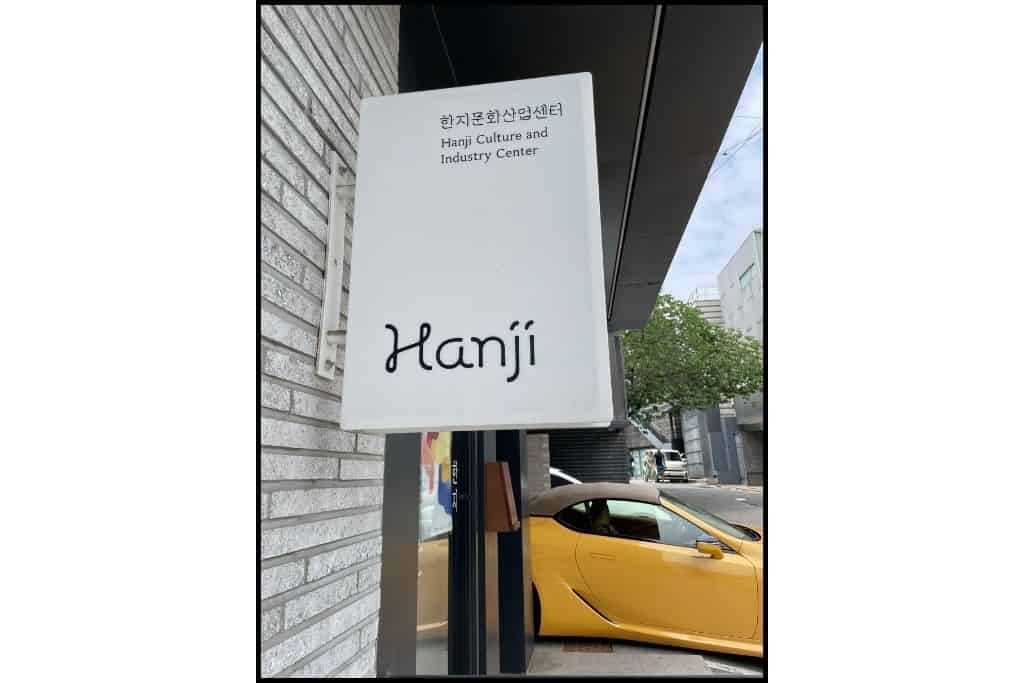
The center features exhibits that showcase hanji’s diverse applications, from calligraphy to window coverings, allowing visitors to learn about its significance in Korean cultural history.

The showroom and an eye-catching display of more than 200 distinct Hanji color swatches are on the first floor.
Four hundred kinds of hanji are stored on the enormous Hanji Table in the middle of the space, arranged according to type, use, and region.
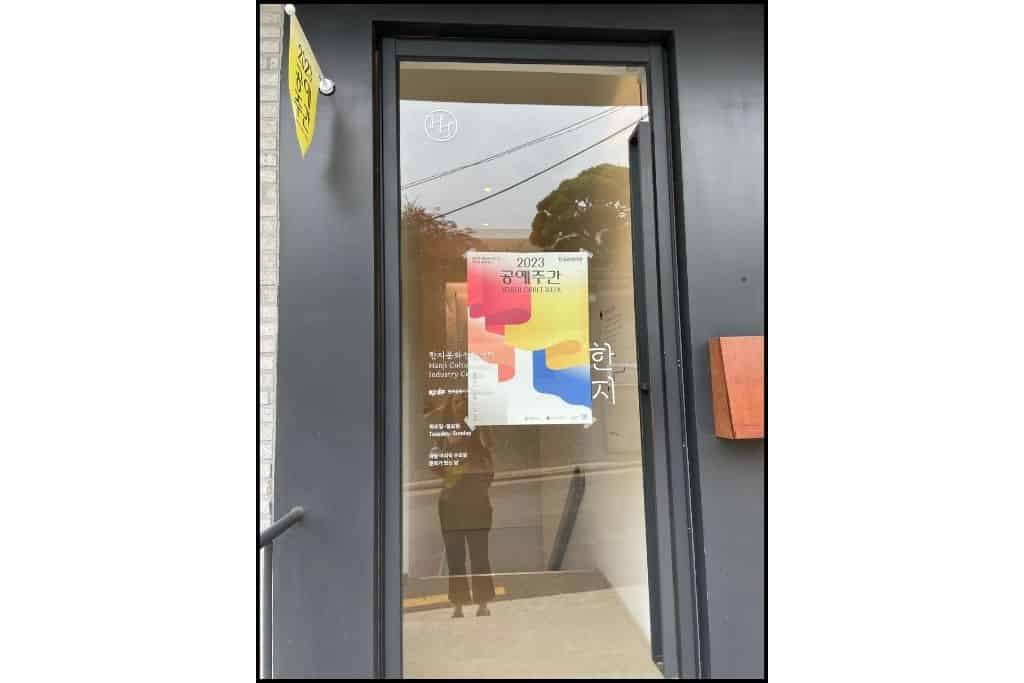
Additionally, in the basement, the center provides hands-on experiences where you can create items such as bookmarks or a hanji mobile.
It’s a must-visit destination for those wanting to connect with Korea’s artistic heritage in a calm and creative environment.
Although the website states reservations are required, I was able to walk in during the day and create a kimchi mobile, which took about 90 minutes.
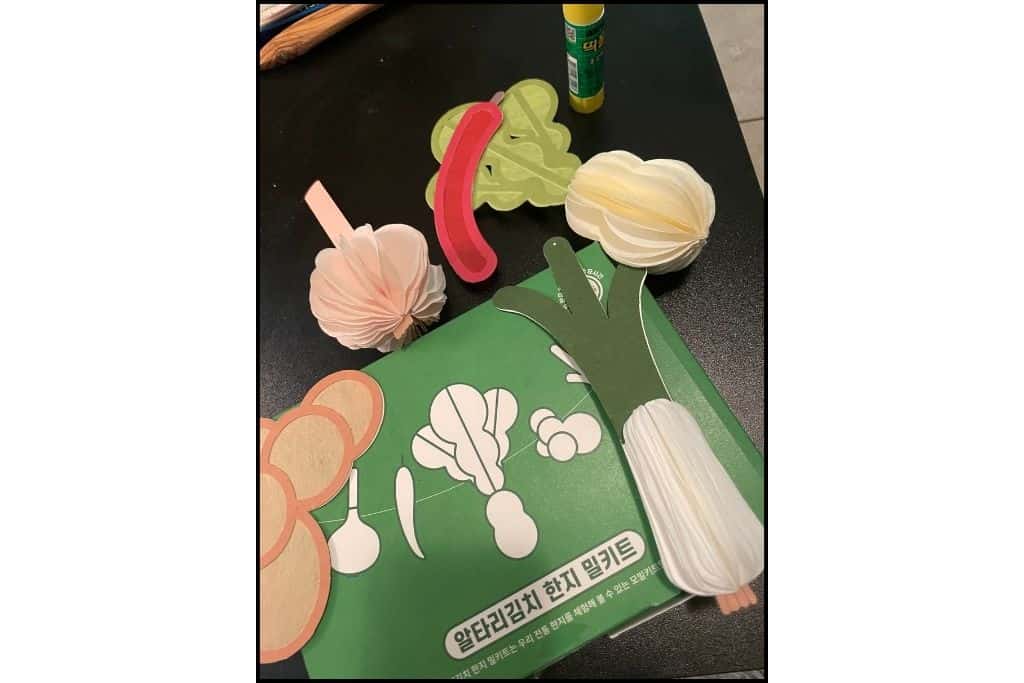
If you plan to visit for crafting, please check the website to reserve a spot or be prepared that you might only be able to complete a craft project after closing, or they could be out of the materials.
No reservations are needed If you want to browse and look at hanji.
Type Hanjogaheon in Papago to get this, 한지가헌 , for Naver or Traditional Korean Paper Heon to look up on Naver map.
I’ll admit that figuring out what to call this interesting place was a challenge, thus finding it in Naver was difficult!
Directions: from Anguk station exit 2, go straight to the intersection and cross the street. Go right and cross the street take your 1st left.
Please check the website for more information and to make any reservations.
6. Base of Namsan Seoul Tower
N Seoul Tower, built atop Namsan Mountain, is one of Seoul’s most iconic landmarks, offering stunning panoramic city views.
Initially built in 1969 as a radio transmission tower, it officially opened to the public in 1980, evolving into a popular tourist destination and symbol of Seoul’s skyline.
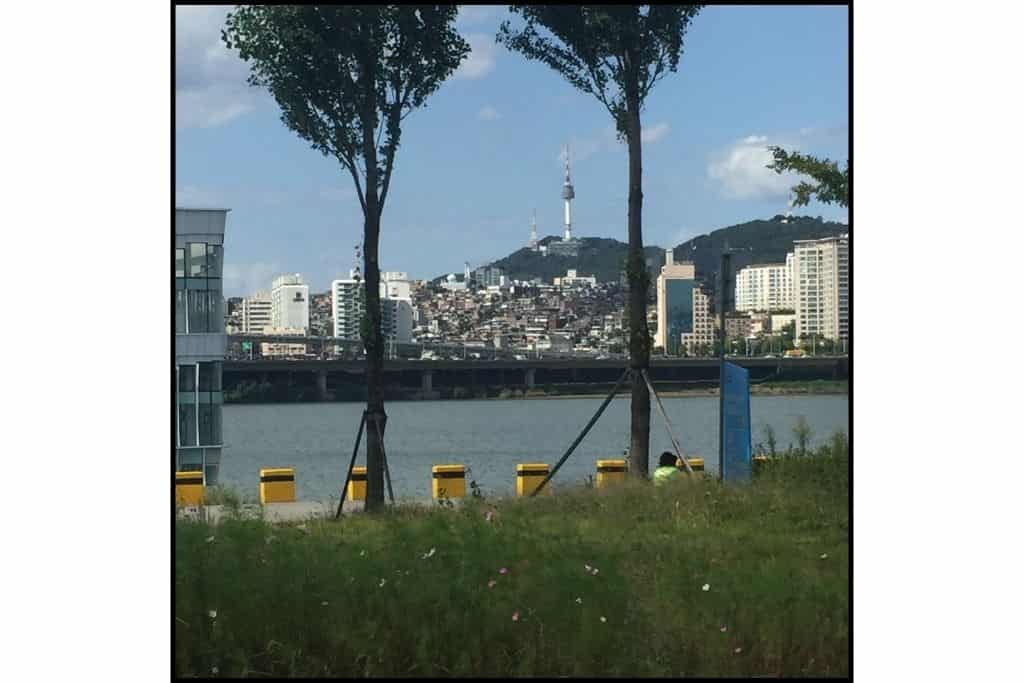
While entry to the observation deck requires a fee, walking around the tower’s base and soaking in the views is one of Seoul’s top free things to do.
While there are trails leading to NST, they can be challenging and take some time to hike. Or you can take the Namsan Circular Bus for a small fare.
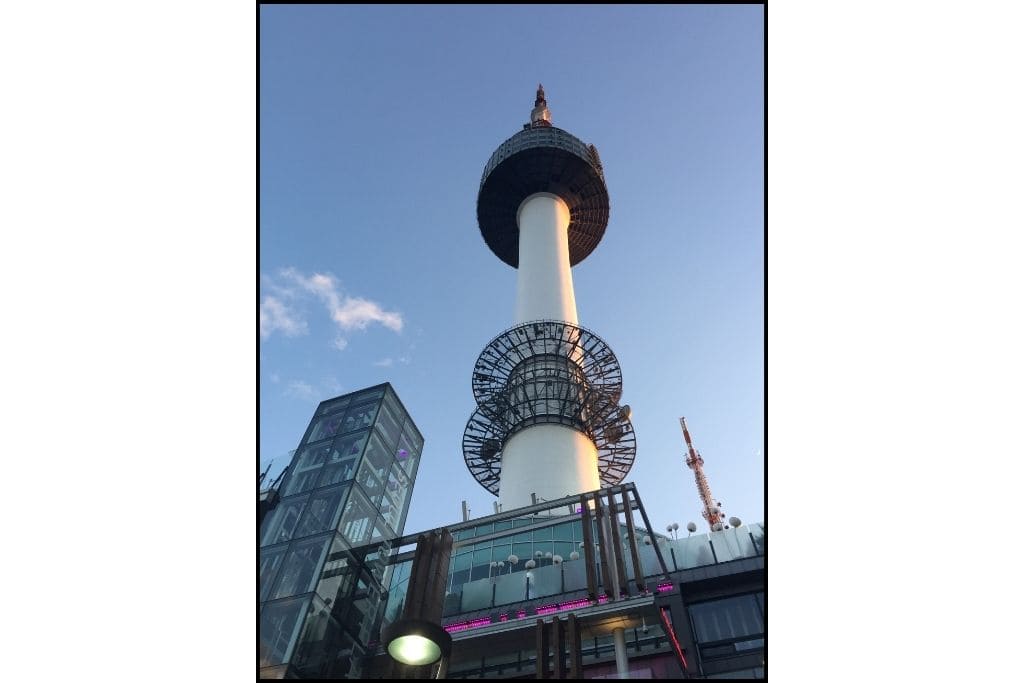
The well-known “Locks of Love” installation is located at the base of the tower. Here, couples personalize padlocks with their names or initials and fasten them to trees or railings as a symbol of their love.
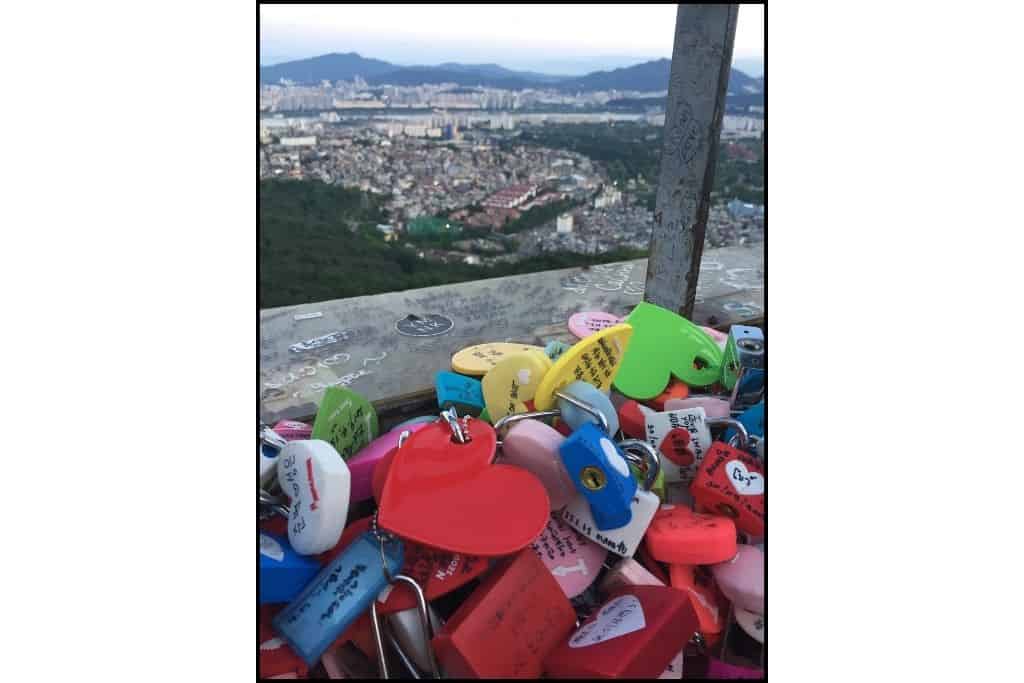
This location also provides breathtaking city vistas and fantastic photo opportunities, making it perfect for romantic or picturesque occasions.
For an extra magical experience, visit N Seoul Tower in the late afternoon to catch the sunset and stay until the evening, when the tower is beautifully illuminated.
Watching the sunset and seeing the tower light up against the night sky is another free thing to do.
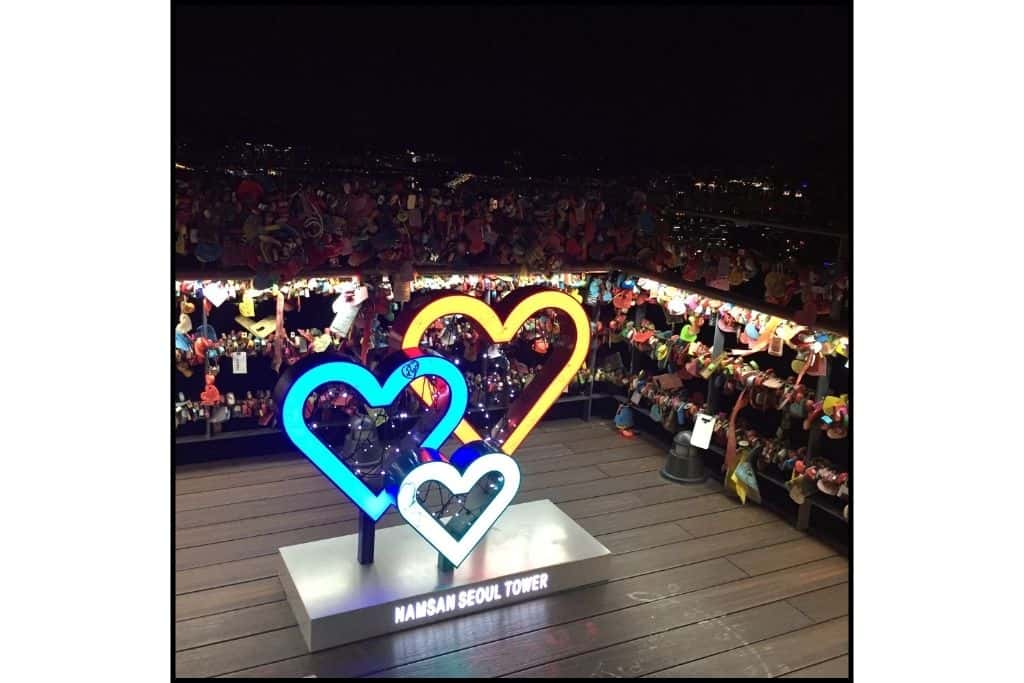
Baekbeom Square Park, located near Seoul Station and Hohyeon Station, is close to Namsan Park and has been a filming location for Korean dramas like “Itaewon Class”, one of the few K-dramas I’ve seen.
Though filled with stairs, the short trail here is perfect for a quick 15-minute stroll, offering scenic views along the way.
With its stunning views, romantic charm, and peaceful atmosphere, N Seoul Tower is a must-visit for anyone looking for budget-friendly, unforgettable experiences in Seoul.
Getting there: Getting to Namsan Seoul Tower by circular Bus for a fee There are 2 buses, 01A and 01B, that will take you there. Detailed information on where to catch it and routes on the website
Shuttle Bus No# 01A : Comes every 6-9 minutes, 6:30 – 23:00, daily, ₩1,400 (cashless, T-money accepted)
Shuttle Bus No# 01B: Comes every 15-18 minutes, 6:30 – 23:00, daily, ₩1,400 (cashless, T-money accepted)
7. Explore the Seoul City Wall
Heunginjimun Gate, often called Dongdaemun Gate, is one of Seoul’s most iconic landmarks and a must-see for travelers interested in history and architecture.
Built in 1398 during the Joseon Dynasty, this massive gate once served as a critical point in Seoul’s defensive wall system. A visit to Dongdaemun Gate is one of the free things to do in Seoul, offering a glimpse into the city’s ancient past.
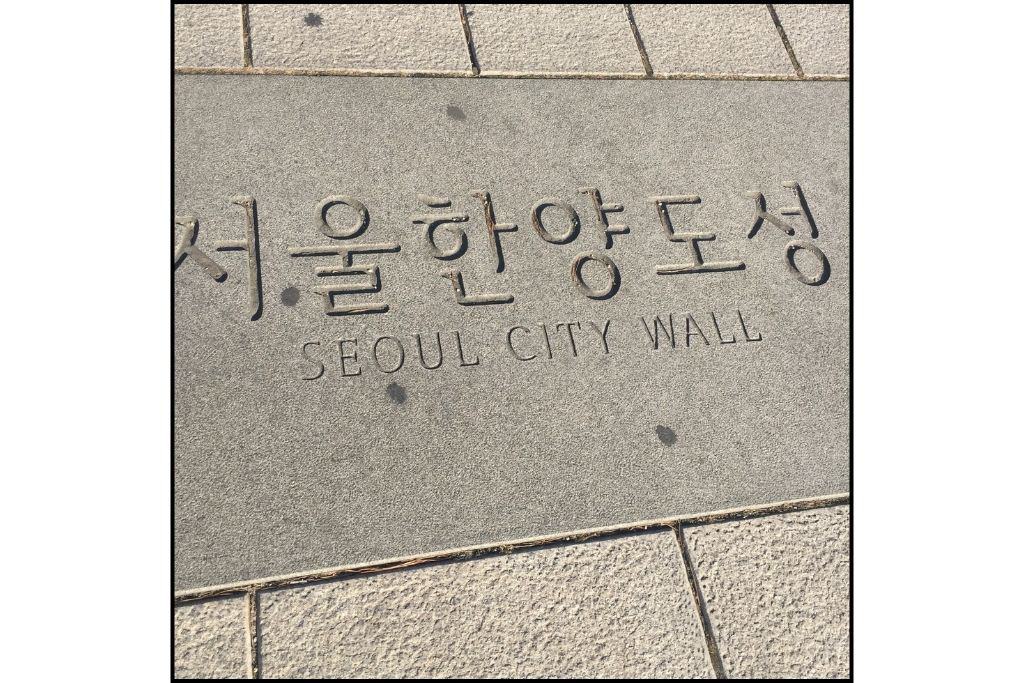
A short walk from the gate takes you to City Wall Park, or Seonggwak Park, where you can enjoy a brief stroll along the remnants of the wall.
From there, you’ll catch views of Dongdaemun Design Plaza (DDP), Dongdaemun Gate, and the city skyline.
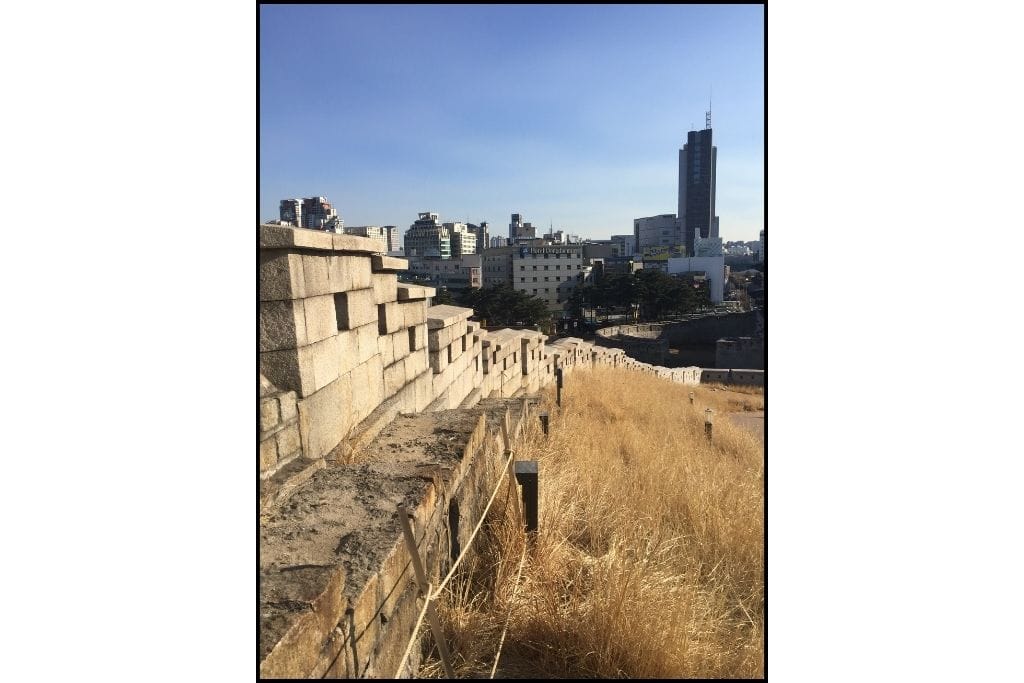
Tucked away on the park’s edge, the Seoul City Wall Museum is another wonderful free activity that offers insights into Seoul’s historical defenses.
The semicircular wall in front of the gate, a rare feature among Seoul’s gates, adds to its distinctive form and was meant to repel enemy incursions.
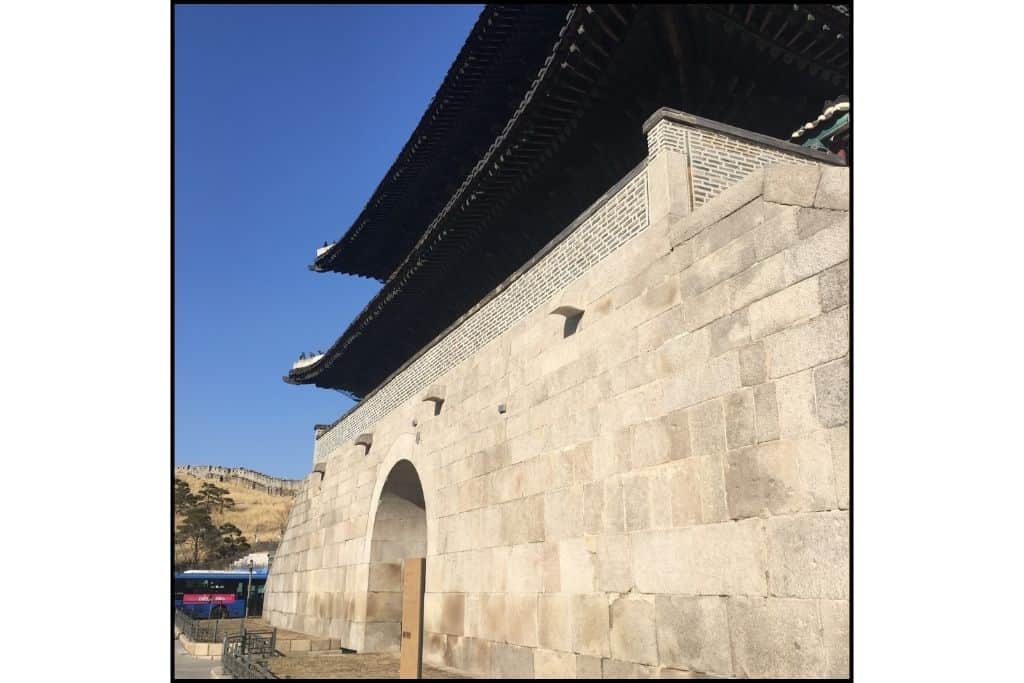
For travelers looking for free activities and cultural experiences, the gate is a must-see location, whether you are strolling around it slowly or snapping pictures of its exquisite architecture.
Directions: to the gate, Dongdaemun station exit 9. You can walk to the park from there.
To the park and museum, you can take exit 9. From the gate, you need to cross the street, cross the next street, turn left, and walk about 133 m, maybe 2 minutes.
8. Dongdaemun Design Plaza aka DDP
Dongdaemun Design Plaza (DDP) is well-known for its futuristic architectural and cultural significance.
Architect Zaha Hadid is well-known for her designs, which combine concrete and aluminum to create structures with flowing, graceful curves that captivate people from all over the world.
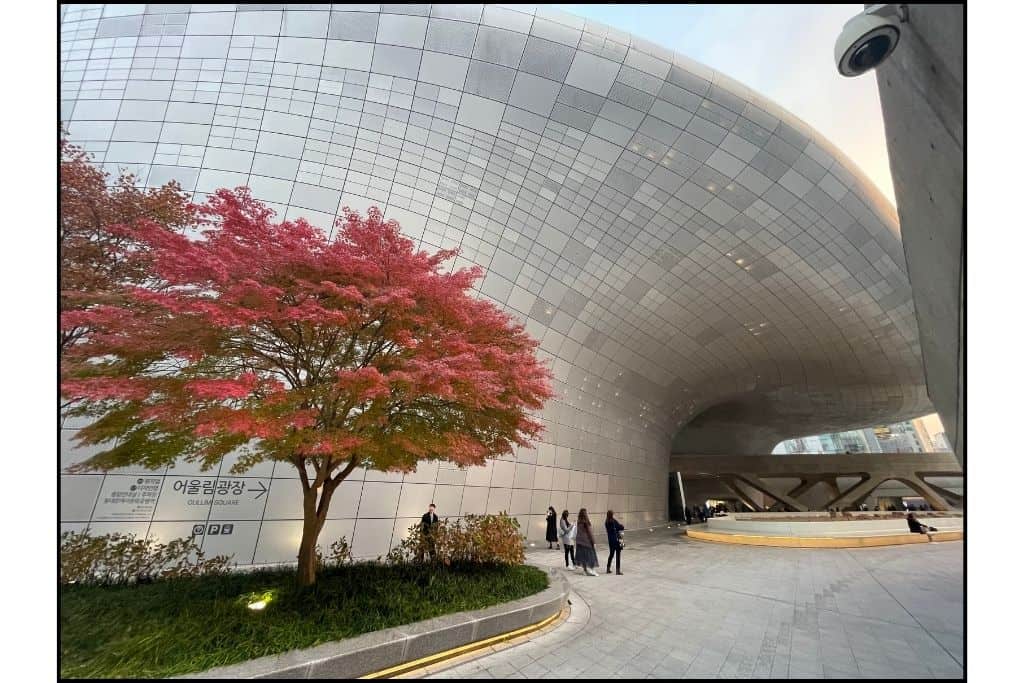
One of the free things to do in Seoul is just stroll around, exploring its exterior, public areas, and nearby park.
There are regularly free exhibitions in addition to the many ticketed events and exhibitions that DDP offers.
DDP’s sprawling plaza is open to the public and offers plenty of room to wander around, making it an ideal spot for photography or leisurely walks.
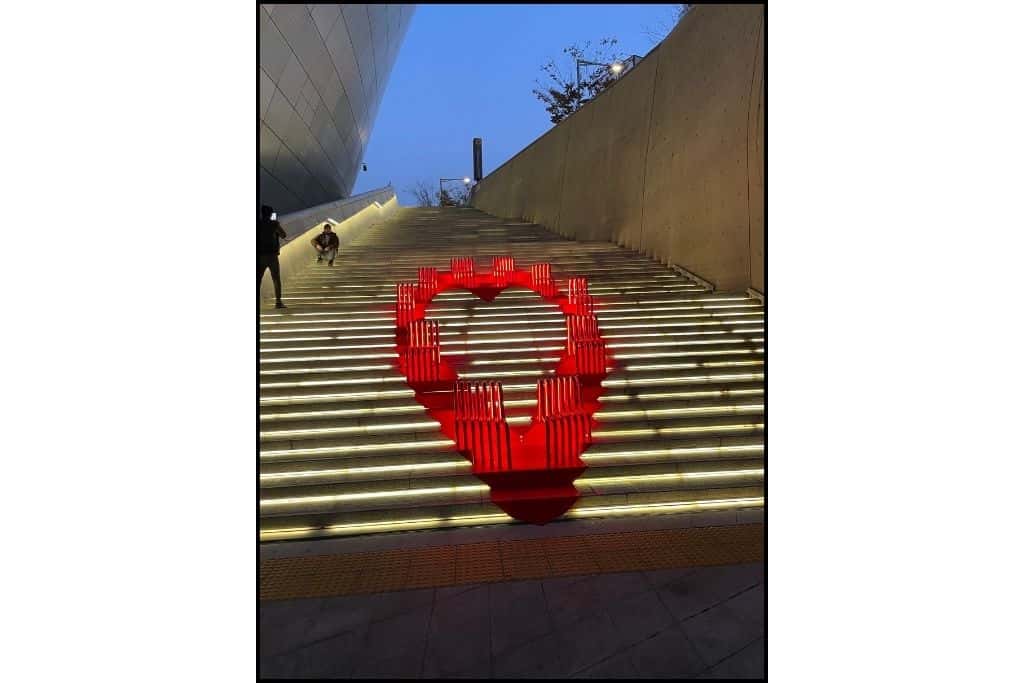
The surrounding landscape is gorgeous when the entire complex is illuminated at night, providing a great view of the city’s skyline.
In addition to its architectural wonder, DDP houses open spaces like Dongdaemun History and Culture Park, which offer green areas for relaxation and exploration.
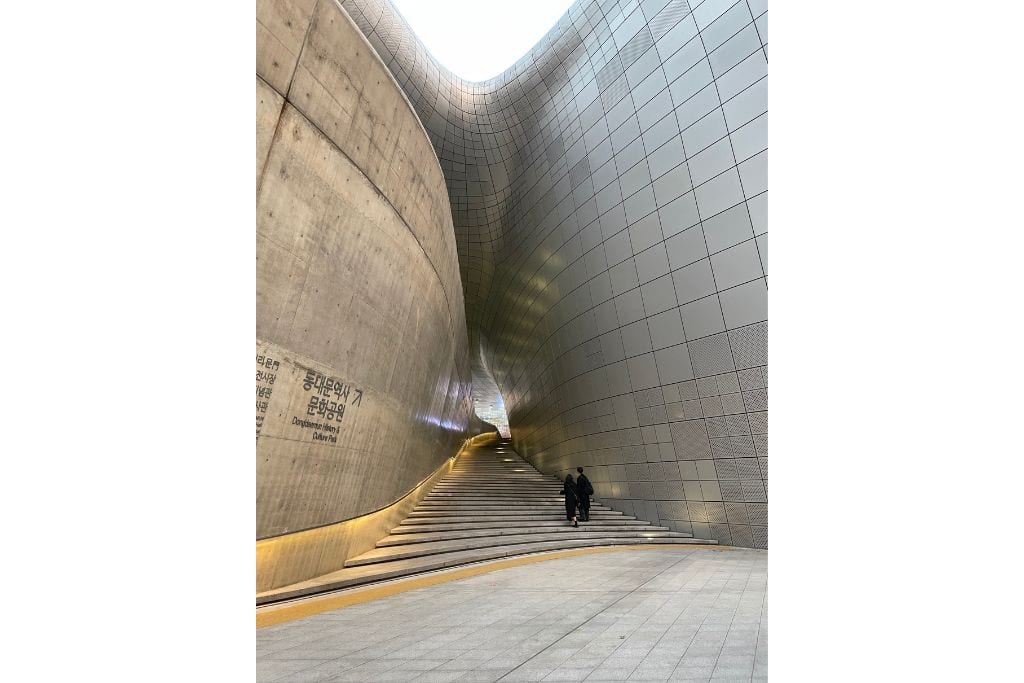
The park also has remnants of Seoul’s ancient city wall, blending the old and new in one place. For those seeking free things to do, DDP and its surrounding parks offer a perfect mix of innovation and history.
If you’re interested in design, you’ll find a variety of public art installations and exhibitions that are free to enjoy.
Walking through DDP’s different sections gives you access to creative displays, a design market, and beautiful outdoor spaces, making it an excellent destination for those looking to enjoy free things to do in the heart of Seoul.
Website for more info HERE
Directions: Dongdaemun History and Culture Park Station Exit 1 places you at the B2 level entrance to Oullim Square, the DDP Market, the Design Lab, and the Museum.
Dongdaemun History and Culture Park Station Exit 2 Places you near the first-floor entrance of the Design Lab and the Dongdaemun History and Culture Park entrance (near Gallery Mun and the underground parking lot)
9. Wander Hongdae
One of Seoul’s trendiest neighborhoods, Hongdae, is well known for its vibrant and youthful vibe.
Buskers, street food, street art, independent music, and shopping are all abundant.
It’s a popular destination for artists and students, providing various free activities such as strolling around its streets and alleys covered in graffiti and taking in outdoor performances.
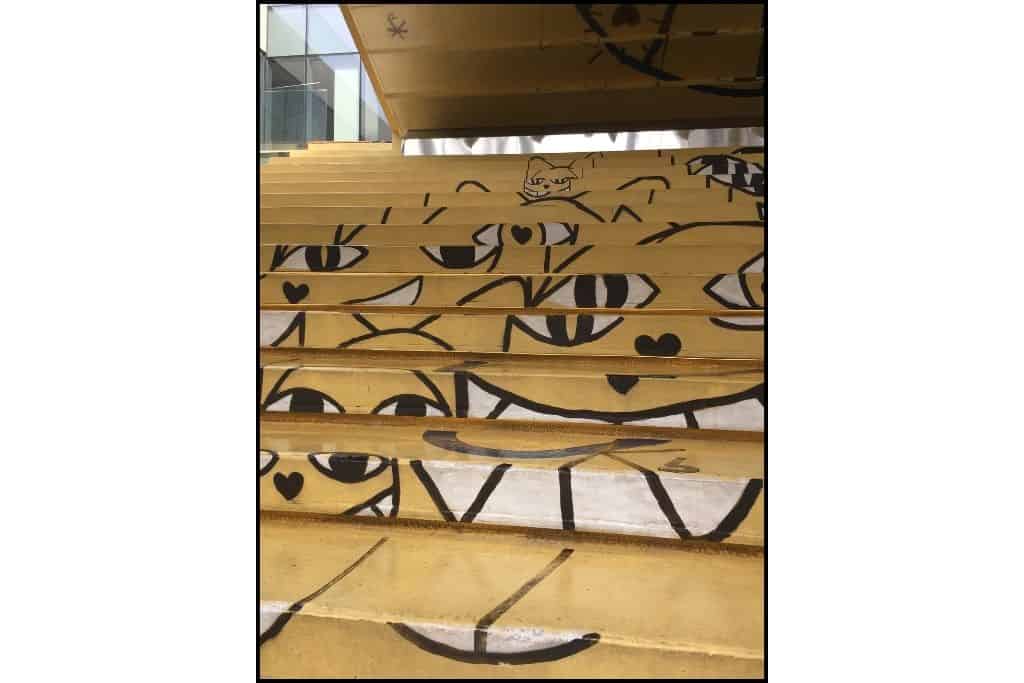
Local artisans display their handcrafted goods and artwork at the Hongdae Free Market, which is held at Hongdae Park on Saturdays and perhaps Sundays from March to November.
Hongdae Park is also close to Hongdae Mural Street, popularly known as Graffiti Alley.
Wausan-ro is the name of the small alleyway across the street from the park. To see every piece of street art, all you have to do is explore the neighborhood.
At Hongik Univ Station, take exit 9 and walk straight to the first cross street and turn Left. walk around 330m until the street light. Cross the street, go to the left of the Uni’s entrance. go straight for about 75m and bear left. Follow the street and find street art.
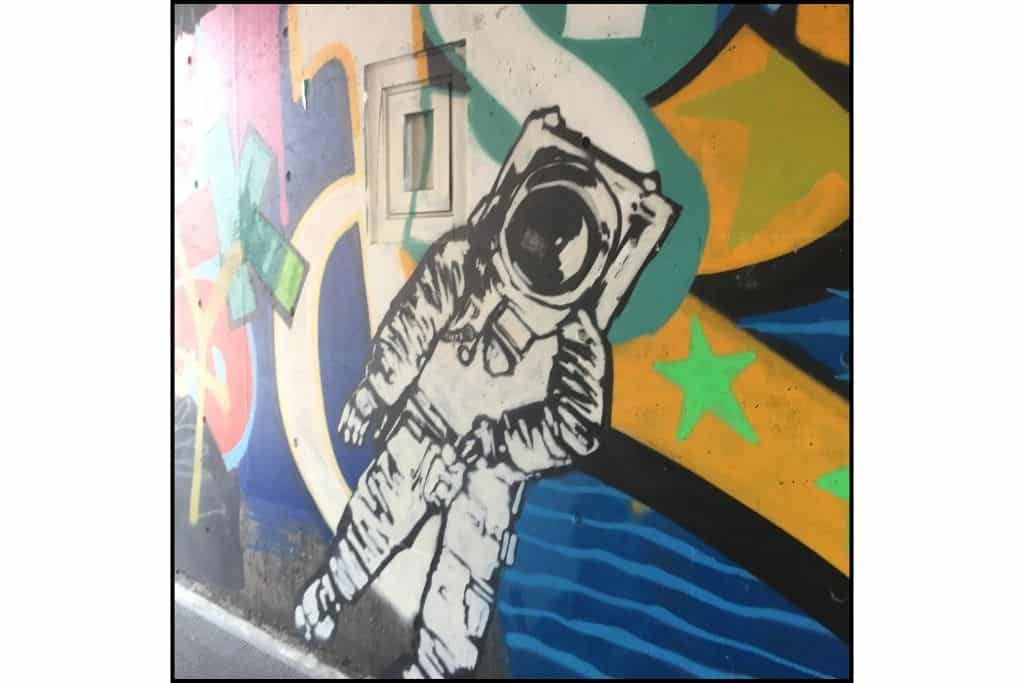
Hongdae truly comes alive as the sun sets with nighttime busking featuring musicians, dancers, and street performers.
These live shows are one of the most popular free things to do in the neighborhood, drawing large crowds to the pedestrian-friendly streets.
Shops tend to stay open late, and street food can be found along Hongdae Street. The vibe of Hongdae at night is a fantastic way to enjoy free entertainment while experiencing Seoul’s thriving youth culture.

From its bustling shopping streets to its parks and live art scenes, Hongdae offers plenty of free things to do for travelers who want to enjoy Seoul’s edgier, artistic side.
Free market Directions: Subway Line 6, Sangsu Station, Exit 1 or 2 (533m on foot, 8-minute walk) Open Saturdays from March to November, 1:00 PM to 6:00 PM.
Mural Street starts in the alley across the street from Hongdae Park, Wausan-ro.
Directions To Hongdae street for shopping, street food and buskers Hongik University station, exit 9 and follow the crowd. Or, Right out of the exit, you can turn left and walk past the first intersection to the bigger road. Then go right and follow the road and follow the crowd.
10. National Museum of Korea
I couldn’t believe this amazing museum was free! I went and visited the digital exhibit and was enthralled the entire time.
I could have stayed and watched it over and over. I highly recommend visiting if you have the time. with its enormous size, pick an area and explore.
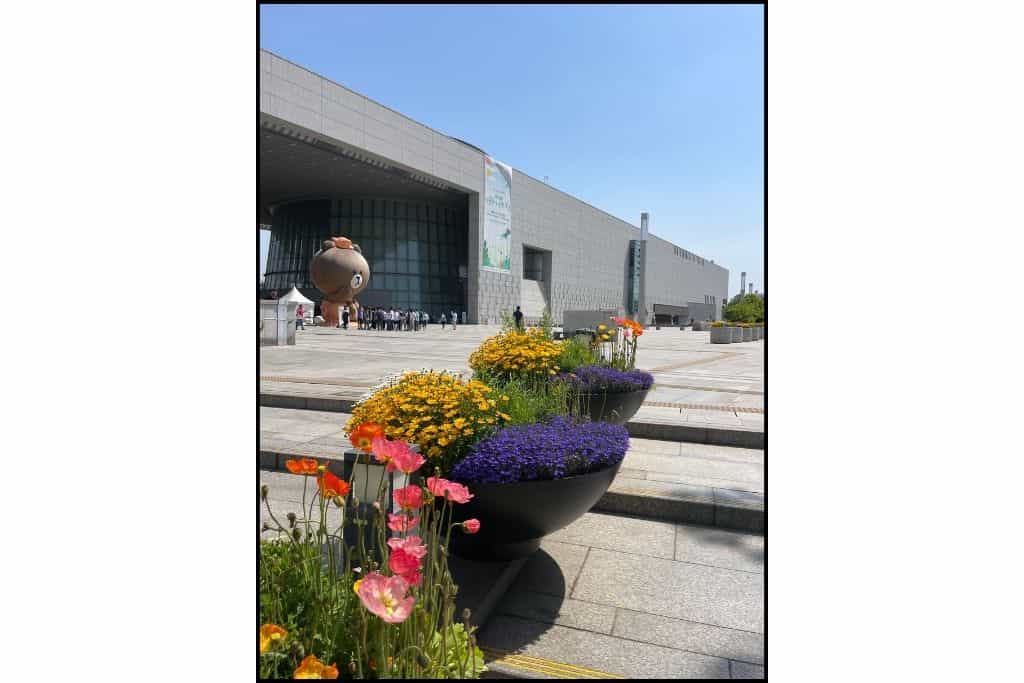
The National Museum of Korea, located in Seoul’s Yongsan District, is the country’s largest museum. It showcases a vast collection of artifacts spanning thousands of years of Korean history.
One of the most remarkable free things to do in Seoul, the museum offers free admission to its permanent exhibitions, which feature everything from ancient pottery to Buddhist sculptures.
It’s a treasure trove of Korean culture and heritage for history enthusiasts.
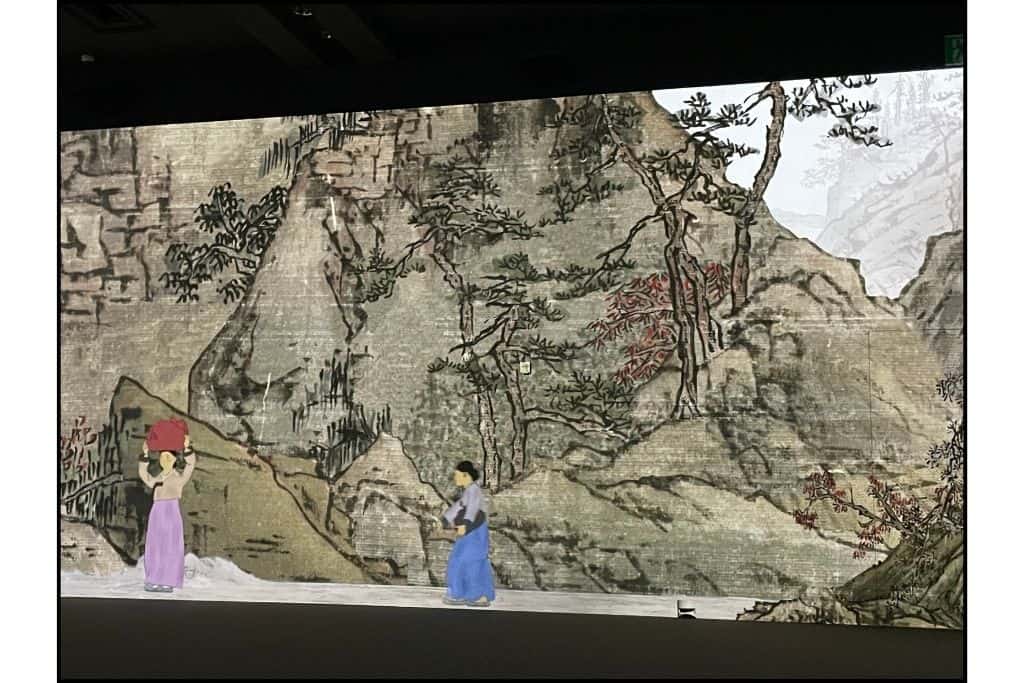
While the permanent exhibits are free to enjoy, one of the museum’s highlights is the immersive digital galleries, which offer a stunning and interactive experience. I absolutely loved the Immersive Digital Gallery 1 and highly recommend it.
The museum also features special exhibitions that require a ticket for entry. These paid exhibitions showcase unique collections and provide deeper insights into specific topics, making them well worth considering for a more enriching experience.
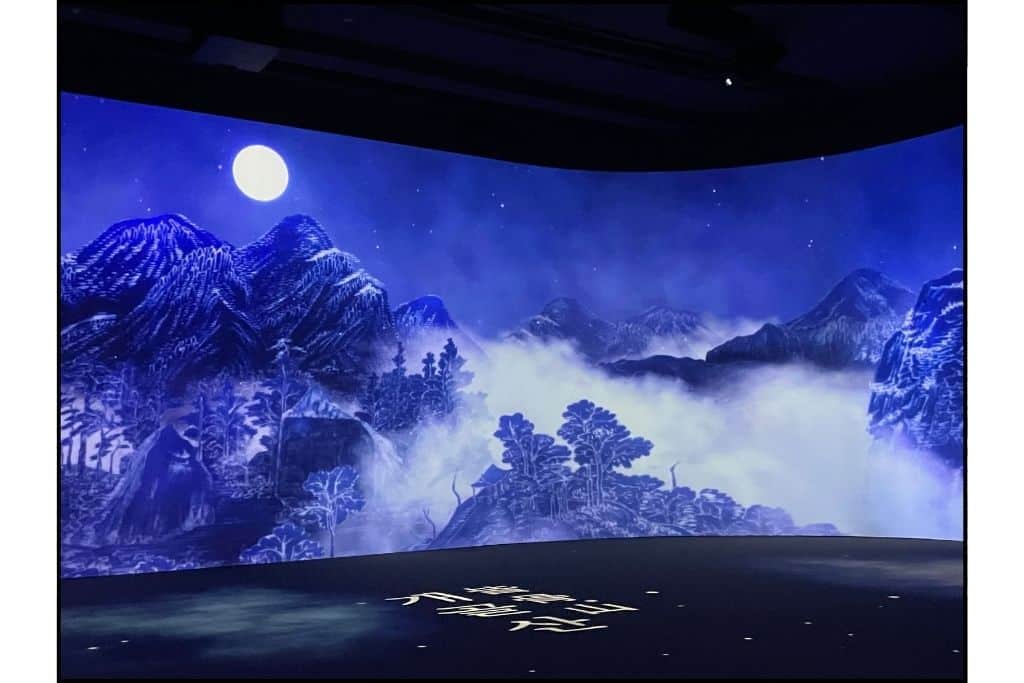
One of the museum’s unique features is its layout, which chronologically takes visitors through Korea’s history and provides a vivid picture of the nation’s progress throughout time.
The museum’s calm outdoor spaces, including a reflecting pond and a traditional pagoda garden, provide serene spots to relax after perusing the indoor displays.
These visitor-friendly spaces are also free and provide a peaceful haven in the center of the busy metropolis.
In addition to its Korean artifacts, the museum houses impressive international collections, including ancient relics from China, Japan, and Central Asia. This makes it not only a hub for Korean history but also a place to explore broader Asian cultural connections.

For travelers looking to engage with both local and global history, the National Museum of Korea is one of the top free things to do in Seoul.
The Children’s Museum is a particularly noteworthy attraction for families. It offers hands-on, interactive displays that introduce young visitors to Korea’s history. Reservations are required.
With free admission to the museum’s main exhibitions, it’s a perfect destination for budget-conscious travelers seeking enriching cultural experiences.
Please refer to the website for hours of operation, reservations for specific exhibits, and any other vital information.
Directions on the subway: From Ichon Station Exit 2, walk 150m toward Yongsan Family Park.
11. Discover the COEX Starfield Library
One of the best free things to do in Seoul is visiting the stunning COEX Starfield Library, located in the COEX Mall.
This underground shopping haven is connected to the COEX Convention & Exhibition Center, a major venue that hosts exciting events, conferences, and shows throughout the year.
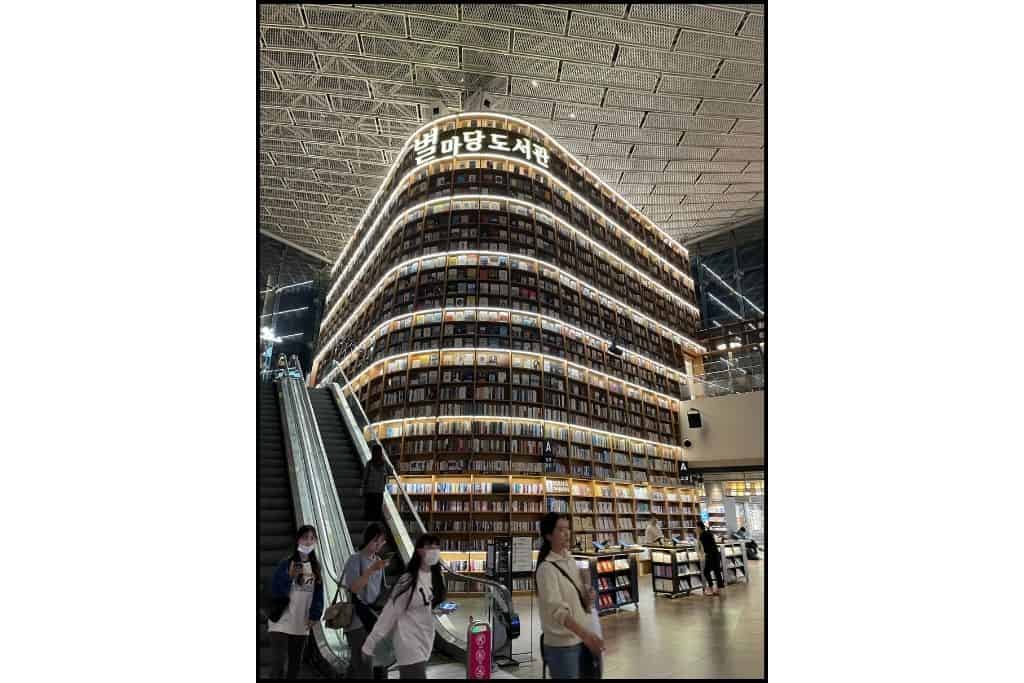
The library, an architectural gem, is a breathtaking sight, with towering bookshelves reaching up to 13 meters high. You can wander through its vast collection of books and magazines, all while soaking in the beauty of the space.
Not only can you explore the library for free, but it’s also a great spot to relax, read, or take photos for your Instagram feed.
Afterward, you can grab a bite to eat at the COEX Mall food court, where you’ll find a variety of affordable dining options to recharge before continuing your Seoul adventure.
12. Check Out Bongeunsa Temple
Bongeunsa Temple is located in the bustling Gangnam district of Gangnam and offers a serene escape from the fast-paced city life.
I am always amazed at how peaceful and quiet this temple is despite being in the middle of Gangnam. When I need an escape from the grind of the city, I come here.

Originally built in 794 during the Silla Dynasty, this historic temple has stood the test of time, serving as a center for Korean Buddhism for over 1,200 years.
Bongeunsa Temple was initially located on the southern slopes of Sudo Mountain but was moved to its current location in 1498 during the Joseon Dynasty.
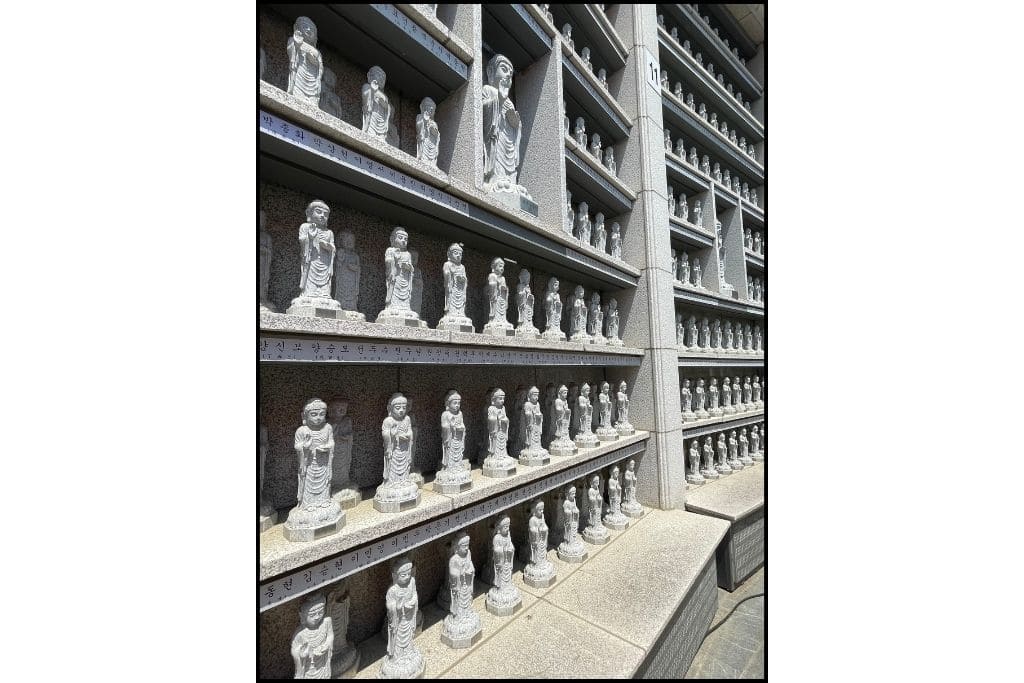
A visit to Bongeunsa is one of the peaceful, free things to do in Seoul, offering insight into the rich spiritual heritage of Korea.
The temple grounds are open to free exploration, where guests can take in the exquisite pavilions, detailed Buddha statues, and traditional Korean architecture.
One of the tallest Buddha sculptures in Korea, standing at a height of 23 meters, is the temple’s representation of Maitreya, the Buddha of the future.
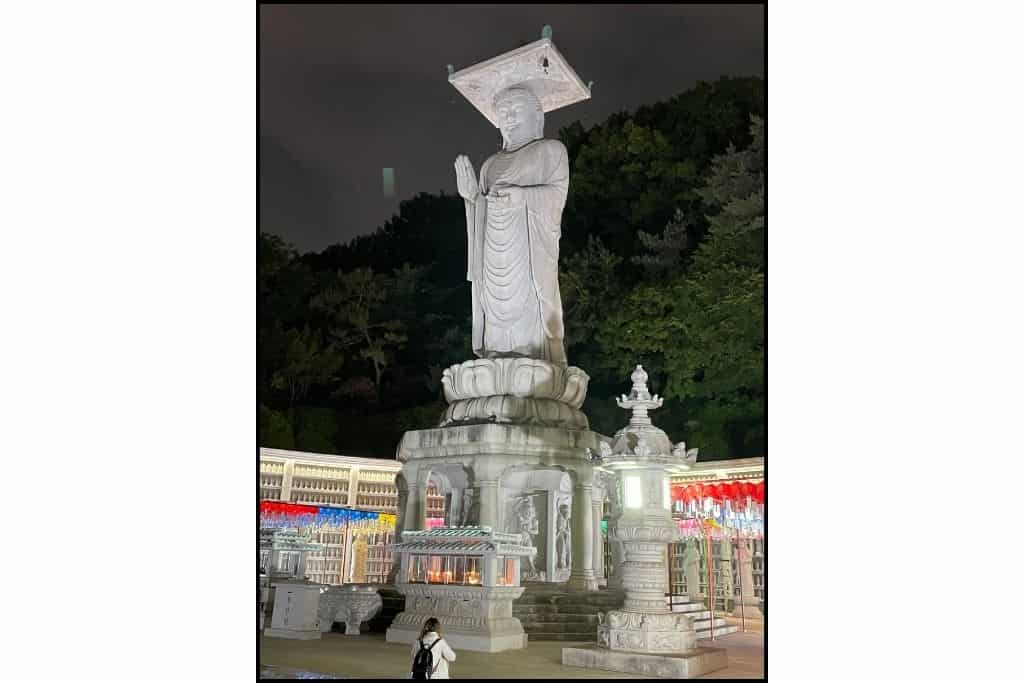
Visitors can find a peaceful oasis in the center of the city by taking a leisurely trek through the woods behind the massive Buddha monument.
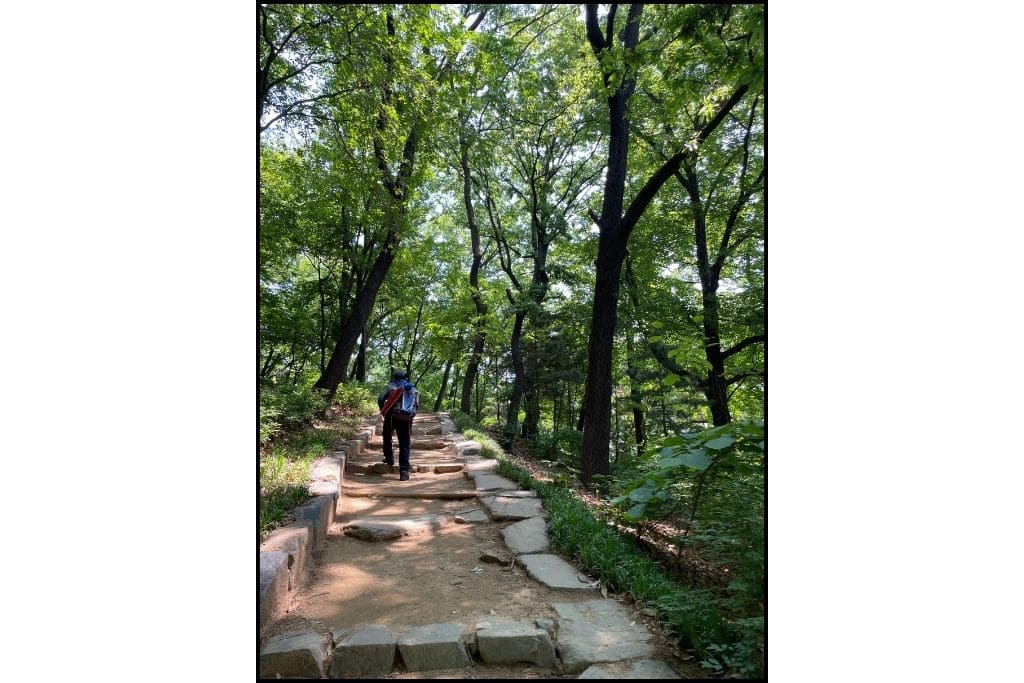
Visitors can find a peaceful oasis in the center of the city by taking a leisurely trek through the woods behind the massive Buddha monument.
The temple provides a stunning contrast between the old and the new when set against Seoul’s contemporary skyline. Bongeunsa Temple is an essential stop for anybody visiting Seoul’s religious landmarks.
Free to visit, Open all year round from 5:00 AM to 10:00 PM
Subvway Directions: Bongeunsa Station exit 1. Go straight & turn right to the temple. About a 3 minute walk.
Samseong Station Exit 5 or 6, then walk either through the COEX mall or on the street in a northward direction.
13. K-Star Road
The luxurious Apgujeong neighborhood’s K-Star Road is a must-see for fans of K-pop and anybody else interested in Korean popular culture.
Seventeen large bear-shaped statues, called Gangandols, line this colorful boulevard, symbolizing well-known K-pop groups, including Shinee, BTS, and EXO, to name a few.
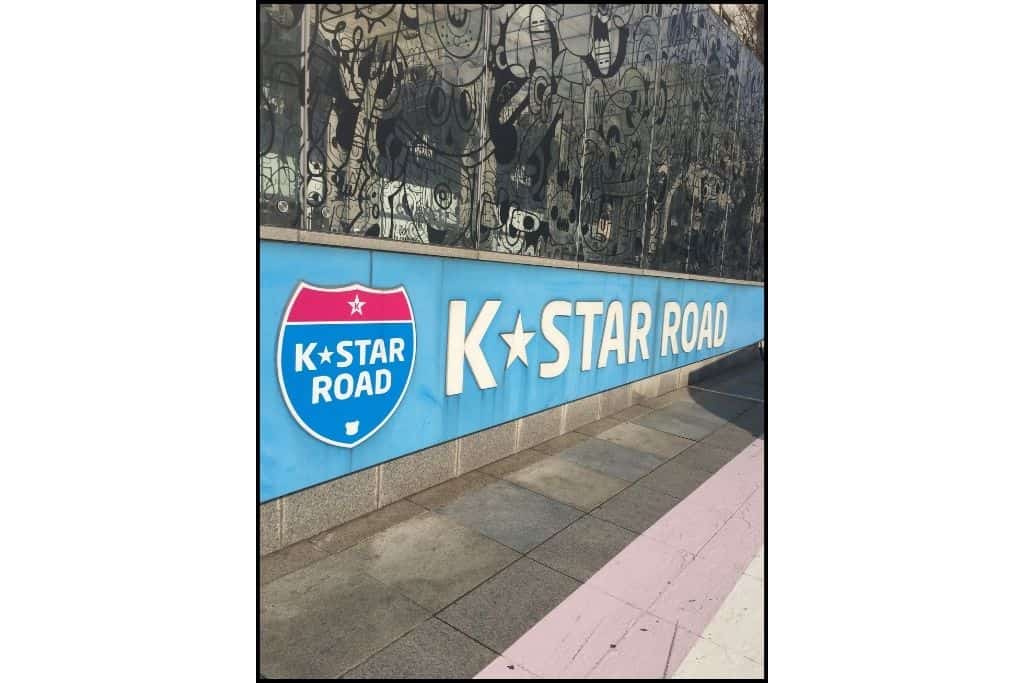
One of the free things to do in Seoul is to stroll down K-Star Road, where visitors can discover the history of the Korean Wave and snap funny photos with these colorful GangnamDols.
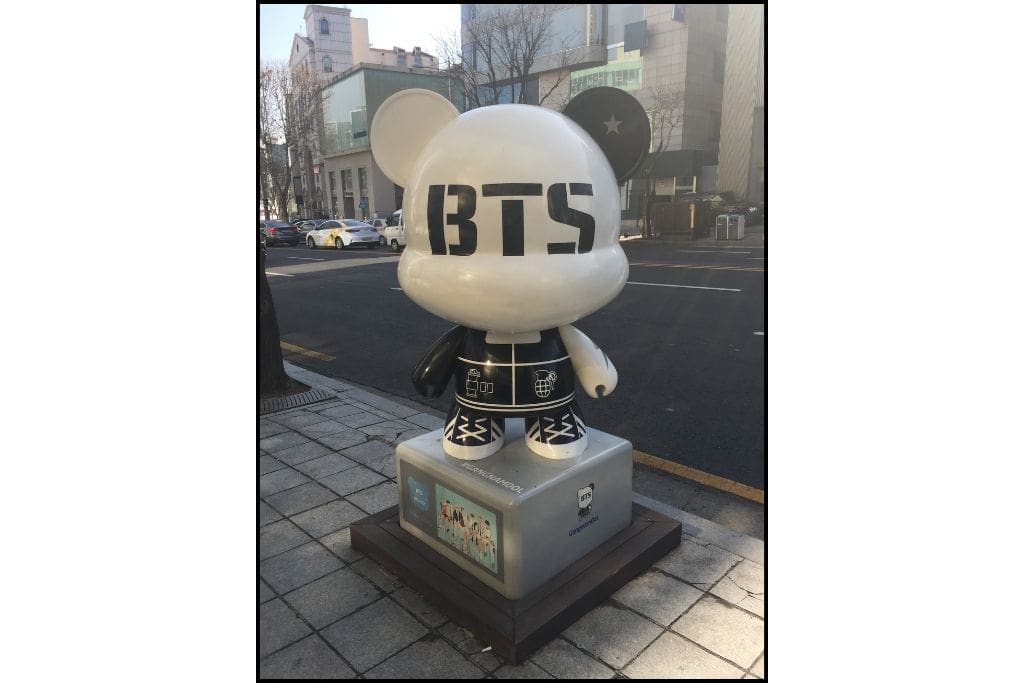
SM, JYP, and Cube Entertainment, three of Korea’s leading entertainment firms where several K-pop artists began their careers, are located on this road.
Without spending a penny, fans can stroll by these agencies in the hopes of spotting their stars and take in the glamorous environment.
Along with upscale retailers like MaxMara, Gucci, Louis Vuitton, Carolina Herrera, and Dior, the strip also has celebrity-themed installations that draw K-pop enthusiasts.
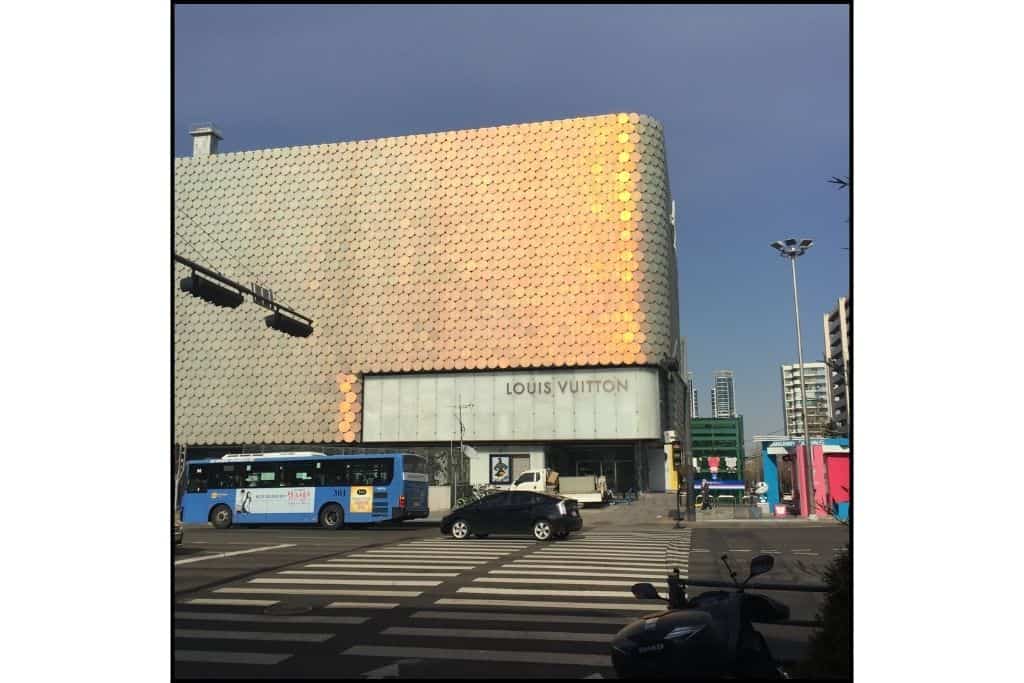
The Gangnam Tourist Information Center, the Galleria and Hyundai Department Stores, and Sinsadong Garosu-gil—a chic street lined with cafes and boutiques—are all conveniently located for travelers to explore.
When I explored K-star Road in 2021, the GangnamDoll Haus, the store to get miniature-sized dolls was closed. I looked online, and the hours are open from 10 AM tp 5 PM with an hour lunch from 1-2.
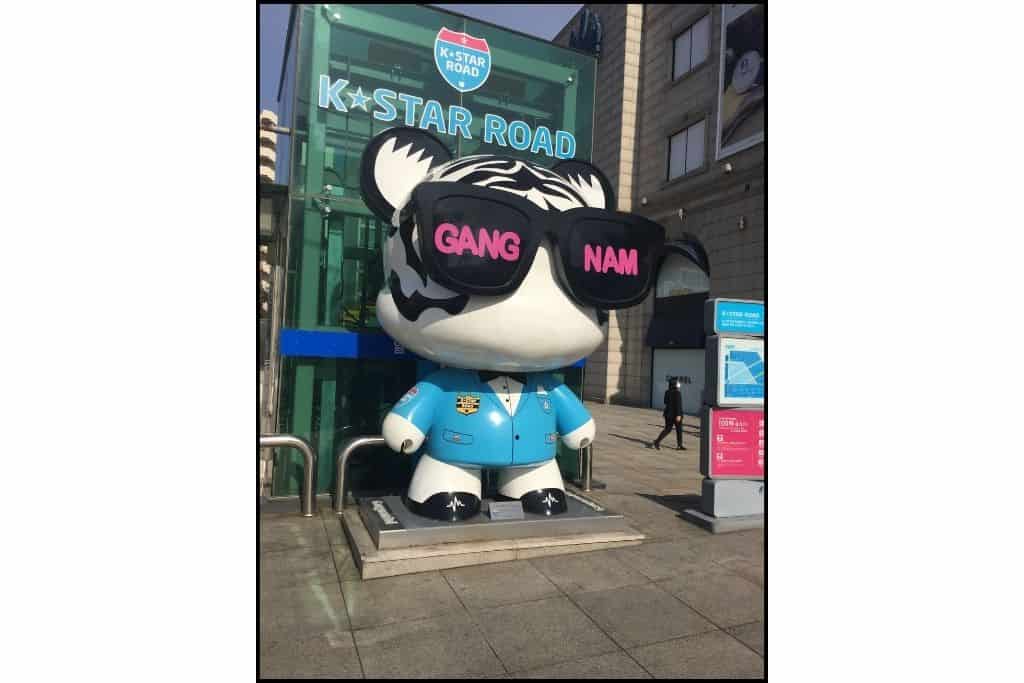
Whether you’re a big fan or just curious about Korea’s booming entertainment scene, this road provides a fun free thing to do in Seoul, immersing visitors in the vibrant spirit of Hallyu culture.
Subway Directions: Apgujeong Rodeo Station exit 2. Once you exit the station, you’ll see a GangnamDol. You should see more of the art dolls along the street; follow those!
14. Understand Ave
Understand Avenue is a tiny cultural complex with diverse stores, galleries, and communal spaces close to Seoul Forest in Seongsul.
It is free to explore. I found this fun area by visiting an exhibit an artist friend was having.
This unique venue is constructed from repurposed shipping containers, giving it an urban, eco-friendly vibe that appeals to locals and visitors.
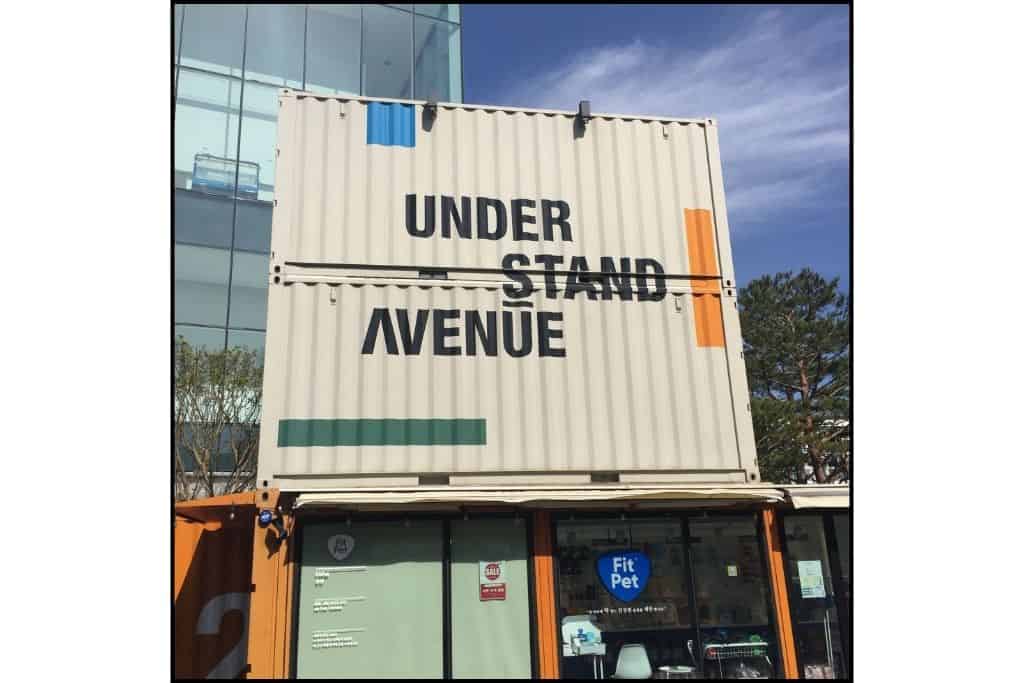
Whether you’re interested in art, independent boutiques, or simply people-watching, Understand Avenue offers a relaxed ambiance ideal for strolling without breaking the bank.
Regardless of your interests in art, independent shops, or just people-watching.
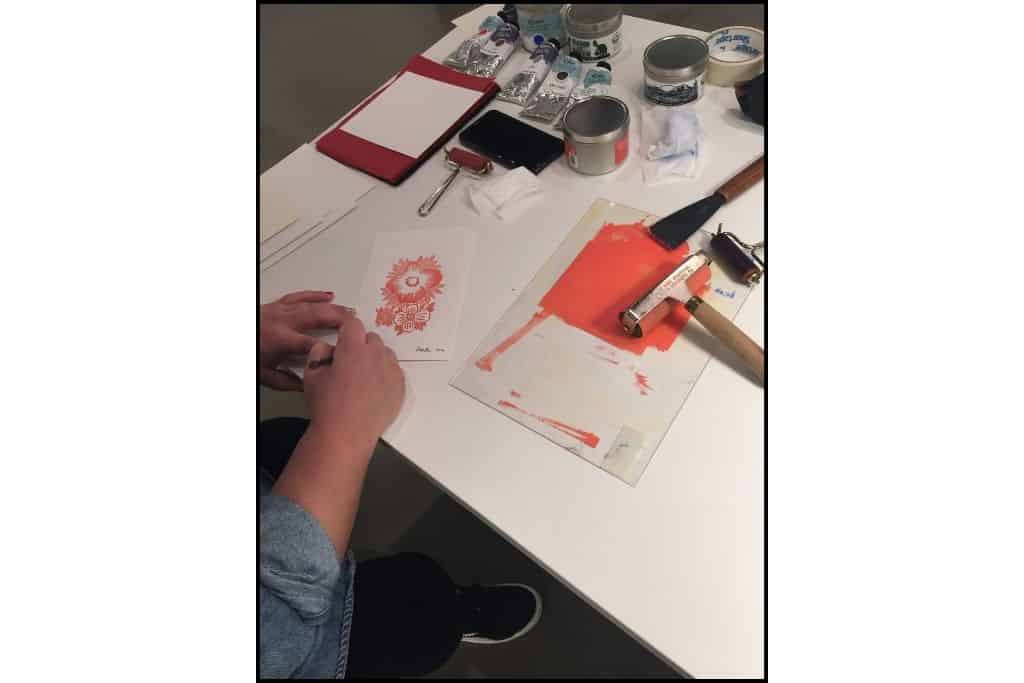
Understand Avenue is an excellent option for travelers seeking free things to do in Seoul.
Regular events, such as outdoor performances, pop-up exhibitions, and art shows, always ensure there is something new and exciting to experience.
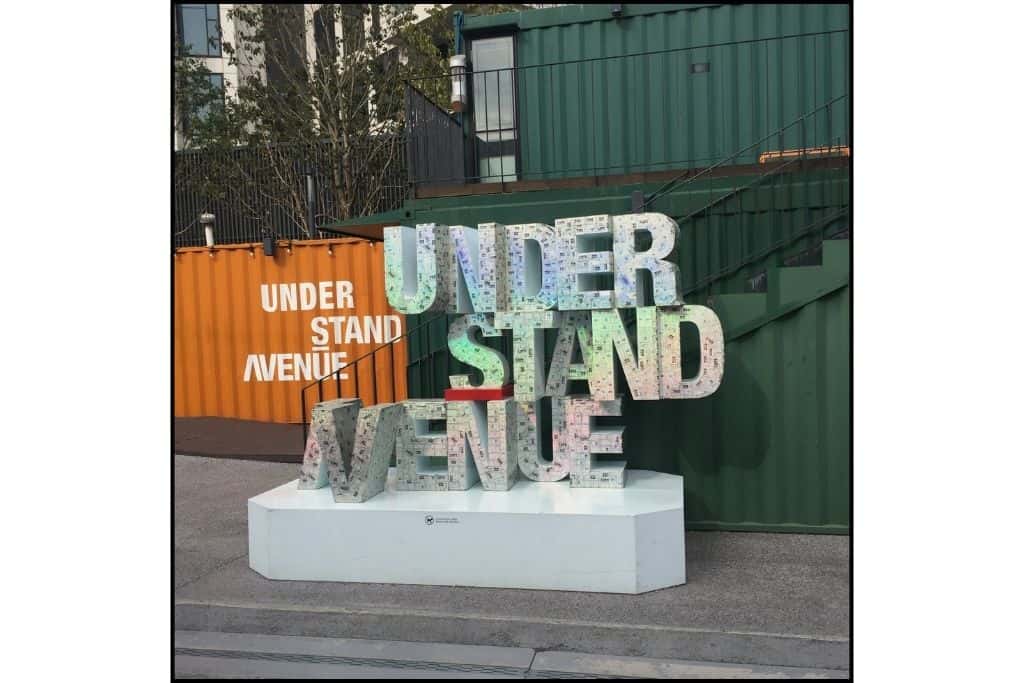
Its proximity to Seongsu-dong—a neighborhood known for its creative, artistic energy—makes it an excellent stop for exploring Seoul’s vibrant local culture.
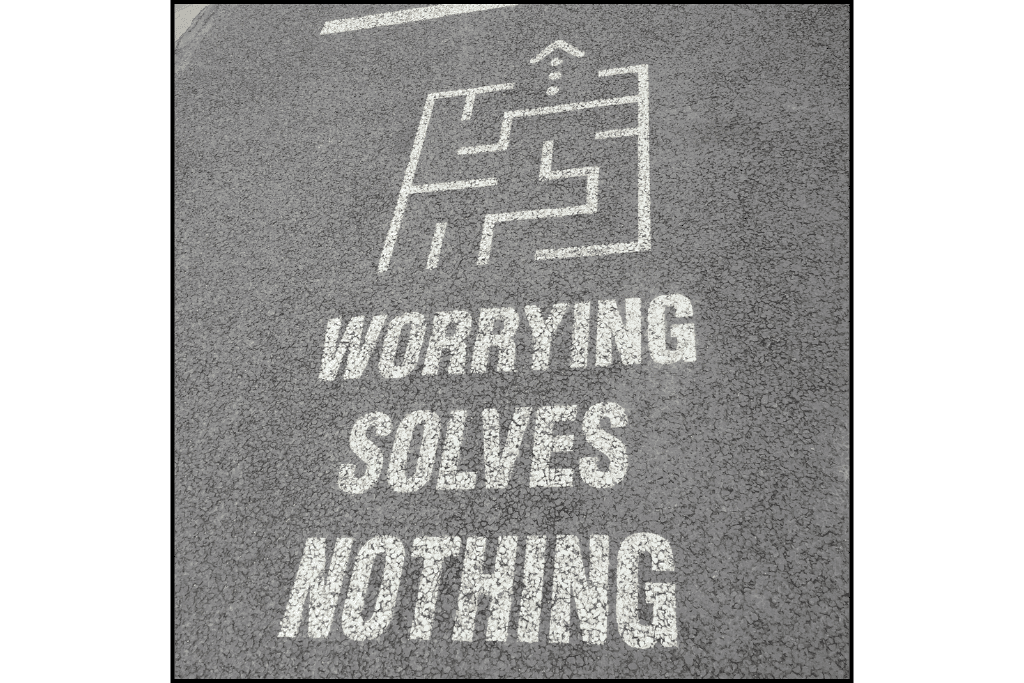
While Understand Avenue is free to visit, you can find affordable snacks and drinks from nearby cafés.
With its fusion of modern design and community-centered activities, the area invites travelers to immerse themselves in Seoul’s artistic scene, making it a hidden gem for those searching for free activities.
Directions: Seoul Forest Station exit 3.
Find more info HERE
15. Jamwon Hangang Grass Garden
I love this park for all the ornamental grasses that change with each season. It’s right along the river, so you can bring a picnic and relax, and do some people-watching.
Jamwon Hangang Grass Garden is a peaceful riverside retreat along the Han River and one of the best free things for nature lovers to do in Seoul.
Its wide, open lawns make it a perfect spot for picnics, sports, or simply lounging while taking in views of the river and the city skyline.
Popular among locals, it features a unique garden of grass that changes color with the seasons. It is a beautiful place all year round for nature enthusiasts and photographers.

What sets Jamwon Hangang Grass Garden apart is its proximity to trendy neighborhoods like Apgujeong and Sinsa. This makes tying in a visit to the park with a stop at well-known cafes or boutiques a breeze.
Cyclists and joggers often use the park’s paved paths, which connect to the extensive Hangang Park trail system.
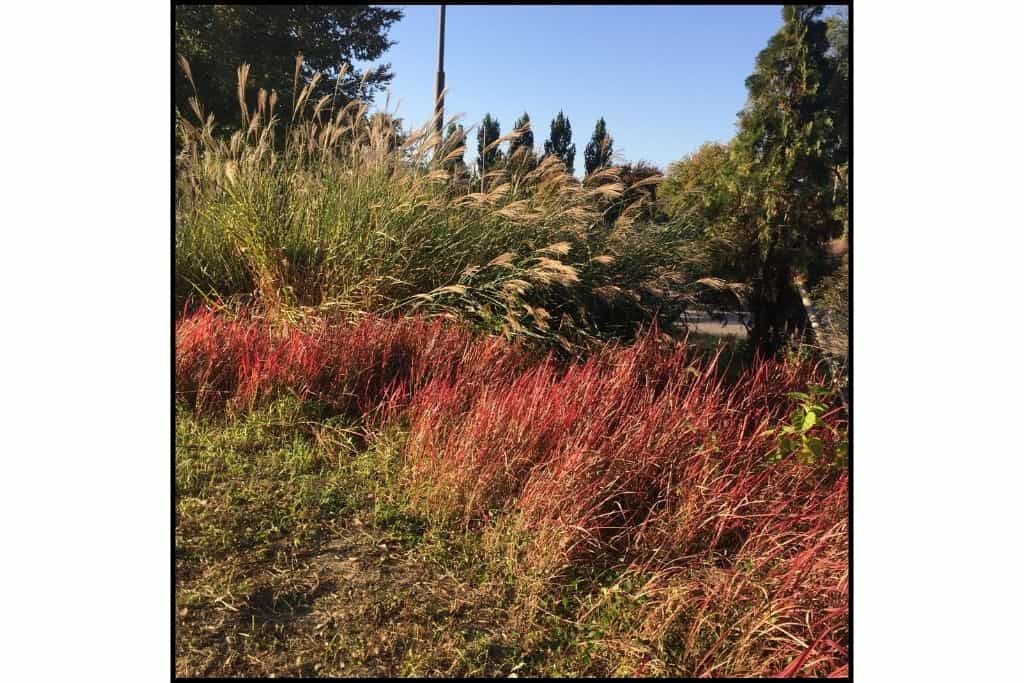
Its natural beauty, especially during spring and fall, draws photographers and casual visitors alike.
If you’re looking for a serene space to relax or enjoy outdoor activities, Jamwon Hangang Grass Garden is a great option that is free.
Directions: Jamwon Station, Exit 4. Proceed straight and make a left turn onto Jamwon-ro 8-gil, the first street.
Turn right at the end of the road and continue to the next traffic light.
Cross the street and proceed down the street toward the underpass to arrive at the Grass Garden on your left. It’s about a 10-12 minute stroll.
Other Popular Free Things to Do
While I haven’t had the chance to visit these places myself, they are all free to experience and offer unique insights into Korean history and culture.
From historical landmarks to vibrant public spaces, each destination has its own charm and is easily accessible by Seoul’s efficient subway system.
I’ve provided brief descriptions and directions so you can explore these spots at your own pace.
16. Changing of the Guard at Deoksugung Palace
The Changing of the Guard ceremony, usually about 30 minutes long, is a colorful reenactment that takes you back in time.
It offers a glimpse into the royal traditions of Korea, complete with vibrant costumes and the rhythmic sounds of drums and horns.
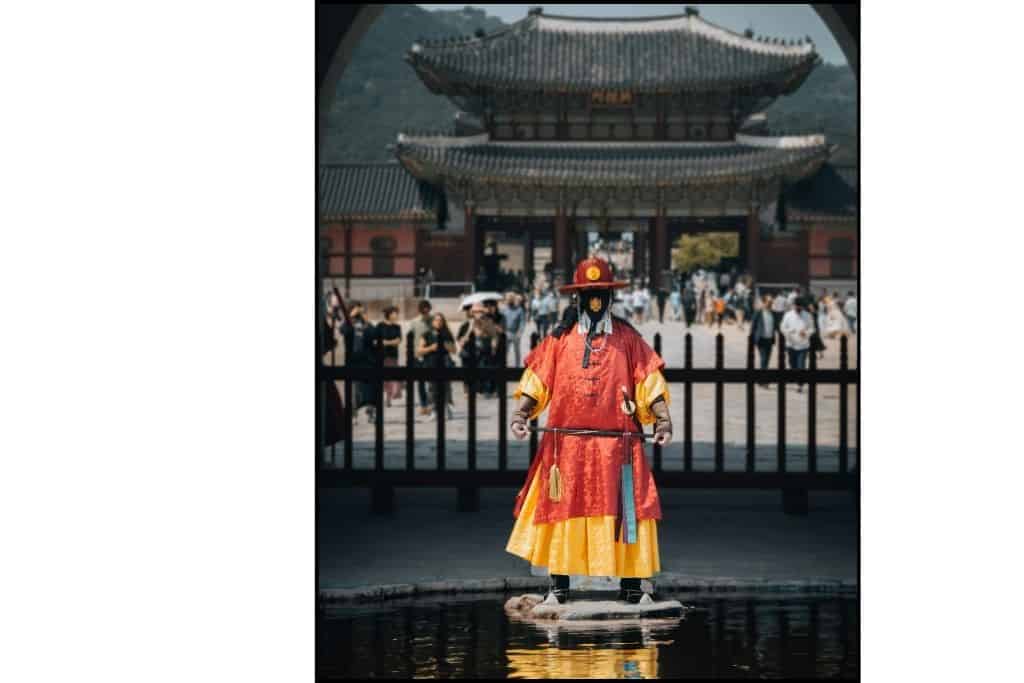
Directions: City Hall Station, then exit 1. The palace is a 72-meter walk from the exit.
When: 11 AM, 2 PM, and 3:30 PM, every day except Mondays, weather dependent, not in the rain, extreme heat, or cold.
17. Deoksugung Stone Wall Road
Before or after watching the Changing of the Guard, take a stroll along Deoksugung Stone Wall Road, a scenic pathway that runs beside the palace’s historic stone walls.
Known for its peaceful atmosphere, this tree-lined road is especially popular for walks, with its beauty changing with the seasons, particularly in autumn.

Directions: City Hall station and come out of Exit 2. Walk straight and in about 2 minutes. The walkway is on your right, starting from the Deoksugung Palace Daehanmun Gate entrance.
18. Pow!Wow! Murals in Seongsu
The Pow!Wow! Murals in Seongsu, the Brooklyn of Seoul, bring the streets to life with stunning artwork, transforming the area into an open-air gallery.
It’s a must-visit spot for art lovers and those who like to explore and wander.
Directions: Seongsu Station exit 3, start exploring!
19. Oil Tank Culture Park
Repurposed industrial oil tanks are transformed into lively art venues and community centers, including a cafe, at Oil Tank Culture Park.
It’s a unique location in Seoul that is close to the World Cup Stadium and across the street from three parks. It features lovely gardens and hosts a range of cultural activities.
Directions: World Cup Stadium Station exit 2, walk around the stadium for about 10 mins.
20. Common Ground
Common Ground is a vibrant shopping destination in Seoul, constructed from 200 shipping containers, where you can explore trendy fashion, unique lifestyle products, bookstores, pop-ups, bakeries, cafes, and delicious dining options.
It’s a lively spot to hang out and capture great photos, especially with its iconic backdrop.
Directions: Konkuk University station exit 6, walk 200m
21. Seoullo 7017
A renovated flyover in the center of Seoul, Seoullo 7017 is now a bustling pedestrian promenade that winds through a verdant sky garden filled with in-season plants and flowers.
With its charming cafes and art installations, this urban area is ideal for leisurely walks and offers breathtaking city views. It’s a pleasant diversion from the busy streets below.
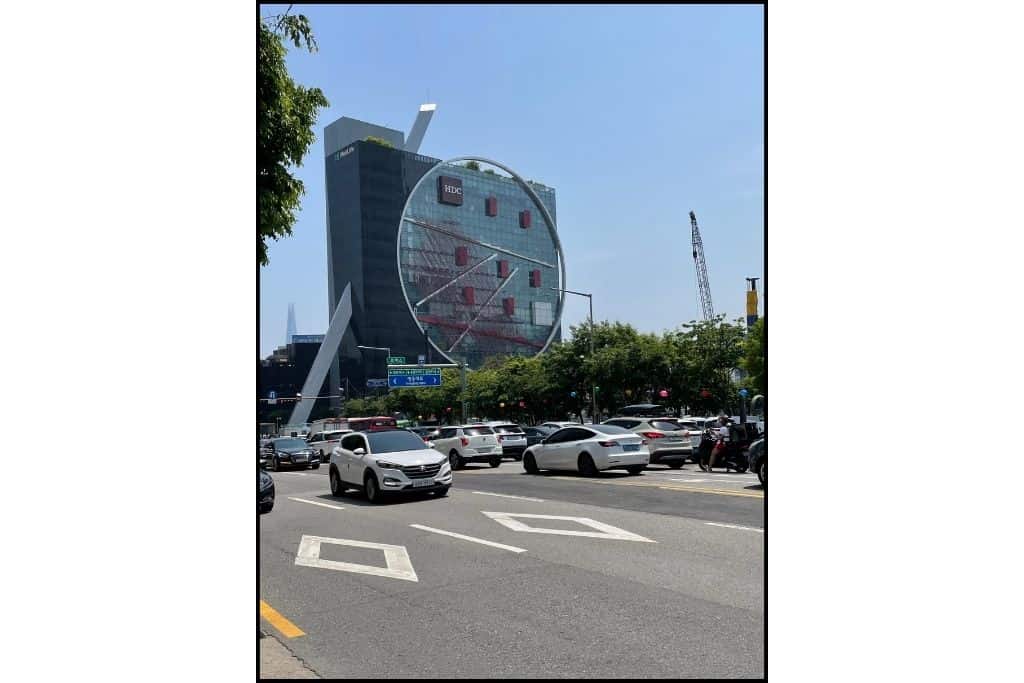
Directions: Seoul Station: Exit 2 and follow the signs. The nearest stairway is across the street from the front of the station.
Or Hoehyeon Station: Exit 5
22. Namdaemun market
Namdaemun Market is one of Seoul’s oldest and largest traditional markets.
You can explore a maze of vibrant stalls selling everything imaginable, from street food and souvenirs to clothes and accessories. Overnight it becomes a wholesale market.
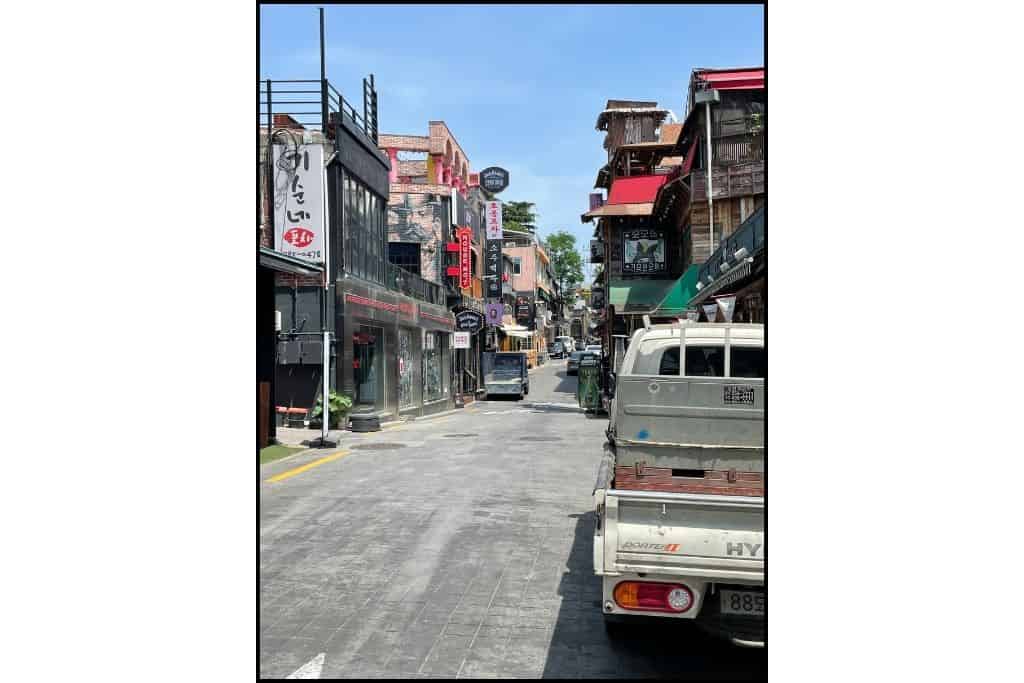
With its bustling energy, affordable prices, and rich cultural vibe, it’s a must-visit spot for shoppers and foodies alike looking to experience authentic Korean market life.
Directions: Hoehyeon Station: Exit 5 and walk 2 minutes to the market
Myeongdong Station: Exit 5 and walk 12 minutes towards Shinsegae Department Store
Seoul Station: Walk across the bridge opposite the station, and the market will be on your left halfway across
23. Blue House Sarangchae
The Blue House Sarangchae is a historical museum, formerly the presidential residence, offering insights into Korean history, culture, and leadership.
Visitors can explore exhibits on past presidents, Korean traditions, and the country’s green initiatives.
It’s host to various cultural events, such as demonstrations of traditional handicrafts and traditional Korean tea tasting, add an interactive element, making it a rich experience for those interested in Korea’s heritage.
It’s conveniently located near Gyeongbokgung Palace, making it an excellent stop for learning about Korea’s modern history.
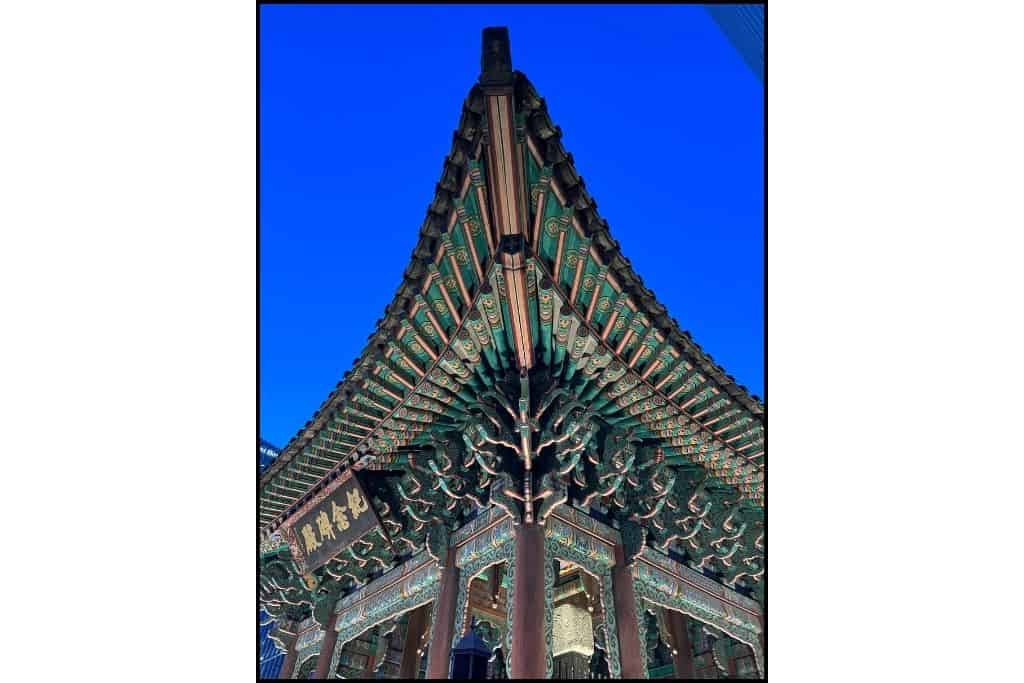
Check the website for more information
Directions: Gyeongbokgung Station and exit through either exit 4 or 5
24. The War Memorial of Korea
The War Memorial of Korea in Seoul offers compelling insight into Korea’s military past.
The museum features seven themed halls with antiques, dioramas, and interactive exhibitions covering a variety of wars, including the Korean War, and more than 13,000 pieces on show.
The outdoor space showcases a remarkable array of military equipment, aircraft, and monuments.
Directions: Samgakji Station Exit 11 or 12
25. Banpo Bridge Moonlight Rainbow Fountain
The Banpo Bridge Moonlight Rainbow Fountain is a stunning display of water, light, and music, featuring over 380 water jets that shoot illuminated streams along the bridge’s length.
Best viewed at night, this beautiful fountain show creates a colorful spectacle over the Han River, making it a popular spot for both locals and tourists to enjoy the city skyline and relax by the water.
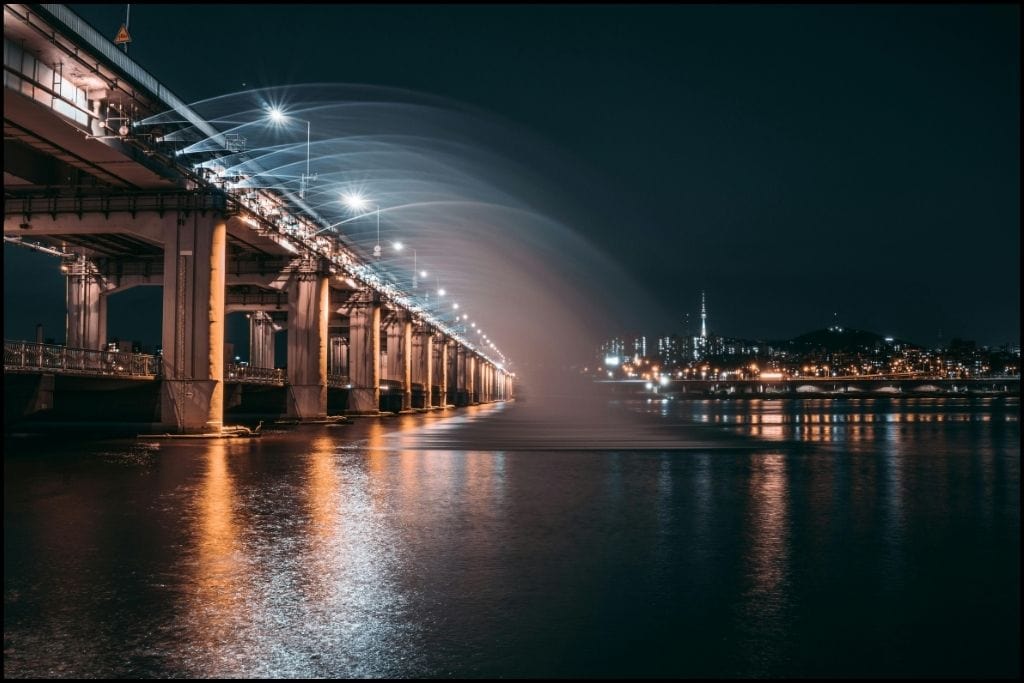
Show times: April-June, September-October: 12:00, 7:30, 8:00, 8:30, 9:00, approximately 20-minute long show
July-August: 12:00, 7:30, 8:00, 8:30, 9:00, 9:30, approximately 20-minute long show
Directions: Express Bus Terminal Station either Exit 8-1 or 8-2. Walk straight for 250m, go right at the Express Bus Terminal intersection. Walk straight for another 400m and cross the road. Go through the underpass to get to the Banpo Bridge.
Dongjak Station Exit 1. Walk straight for 20 m until you reach the Banpo Jugong Apartments, make a left turn, and walk straight for 900 m until you reach Banpo Hangang Park.
FAQ
Depending on your vacation style, traveling to South Korea can be reasonably priced. There are many affordable dining options, including casual restaurants and street food, as well as affordable public transit, such as buses, subways, and even taxis.
Although lodging options vary, you can find reasonably priced hotels and guesthouses, particularly outside of popular tourist destinations. It truly depends on your tastes and financial situation, though, as some activities, such as upscale dining or shopping, might increase your costs. There are plenty of free and low-cost activities to enjoy during your visit.
Despite being a big city, Seoul is walkable in well-known neighborhoods like Myeongdong, Hongdae, and Insadong, with many attractions nearby. Even though you can walk through these locations, you might want to consider using public transit to see other sections of the city. Longer distances are easily navigated thanks to the vast bus and subway system, guaranteeing you can take advantage of everything Seoul has to offer!
Staying connected in South Korea is easy, thanks to the widespread availability of fast mobile networks. One of the most convenient options is using an eSIM, which lets you avoid the hassle of getting a physical SIM card.
You can activate your eSIM remotely, and it works just like a regular SIM, but without needing to swap out cards. This is especially handy for tourists, as you can switch to a local plan for data and calls as soon as you arrive.
The Wrap-Up: Free Things To Do In Seoul
While I may not have personally visited every spot, each destination is accessible and offers its unique perspective on the vibrant tapestry of Korean culture.
I hope this guide inspires you to dive into Seoul’s rich offerings, making the most of your adventure while keeping your budget intact. Happy exploring!
Seoul is a city brimming with free things to do. I have touched upon the many opportunities for memorable experiences without costing a dime.
From cultural landmarks to serene parks, there’s something for everyone, whether you’re a history buff, an art lover, or just looking to unwind.
